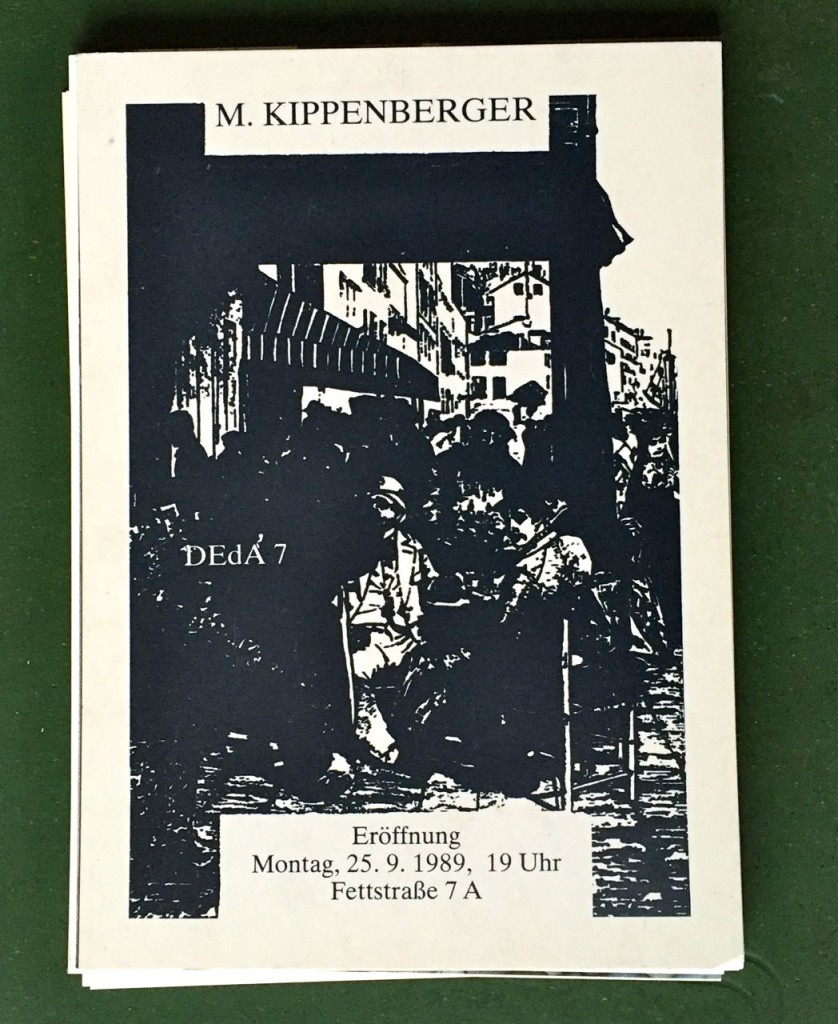
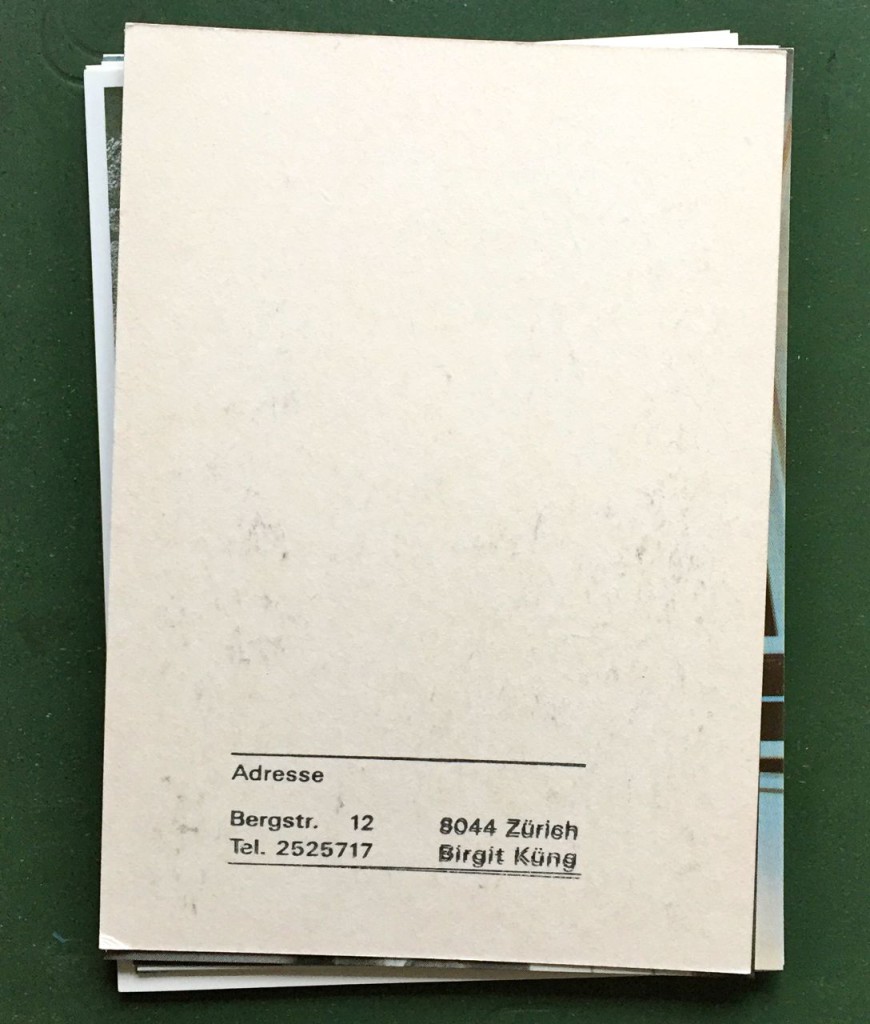
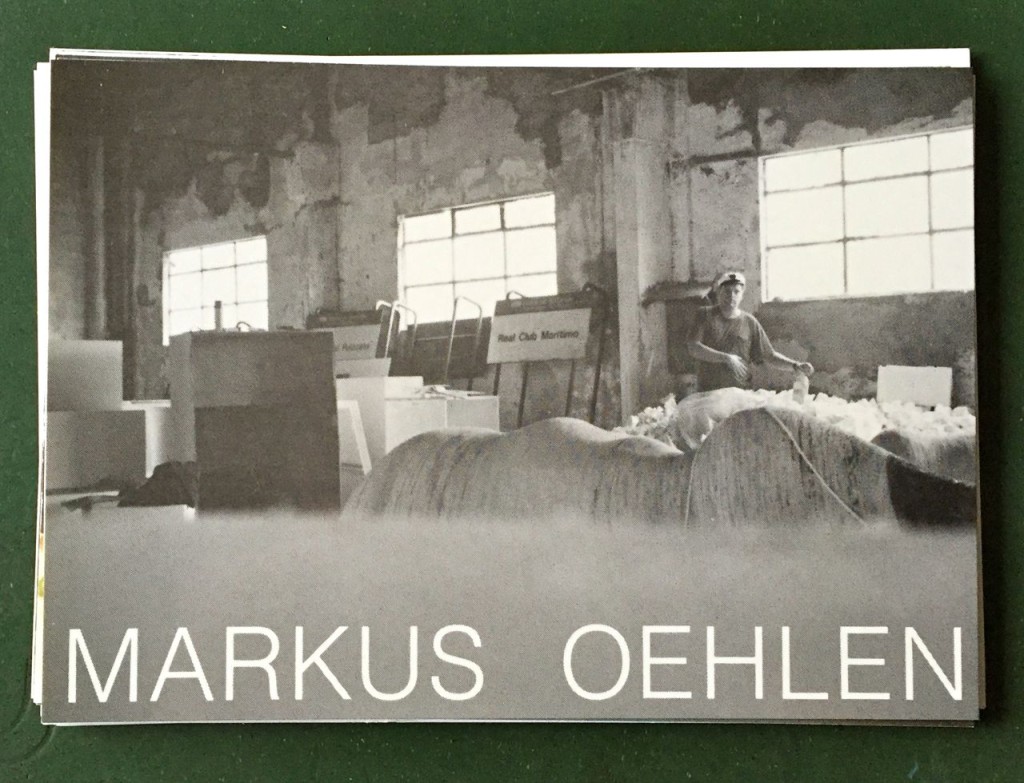
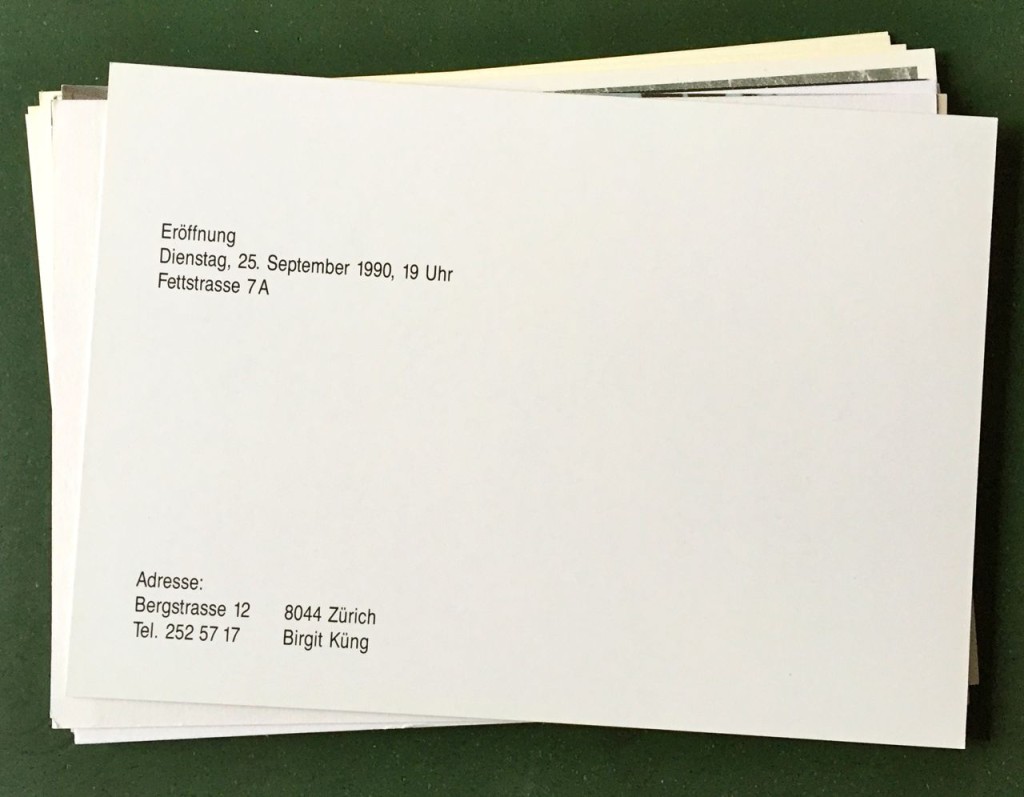
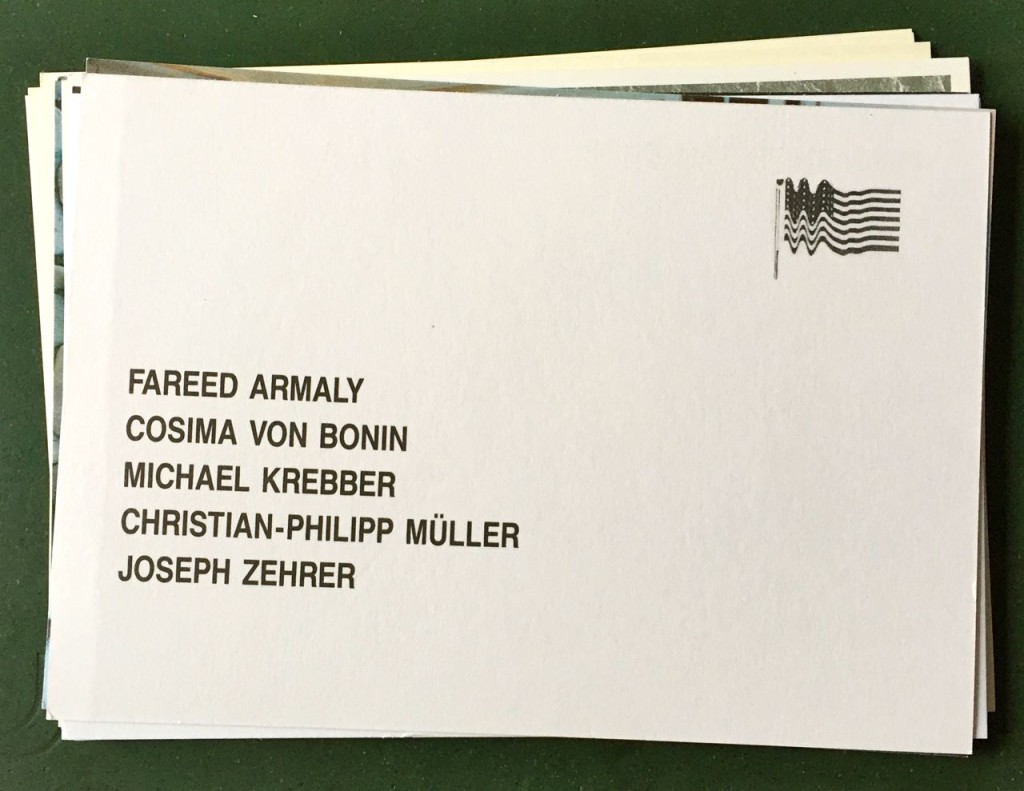
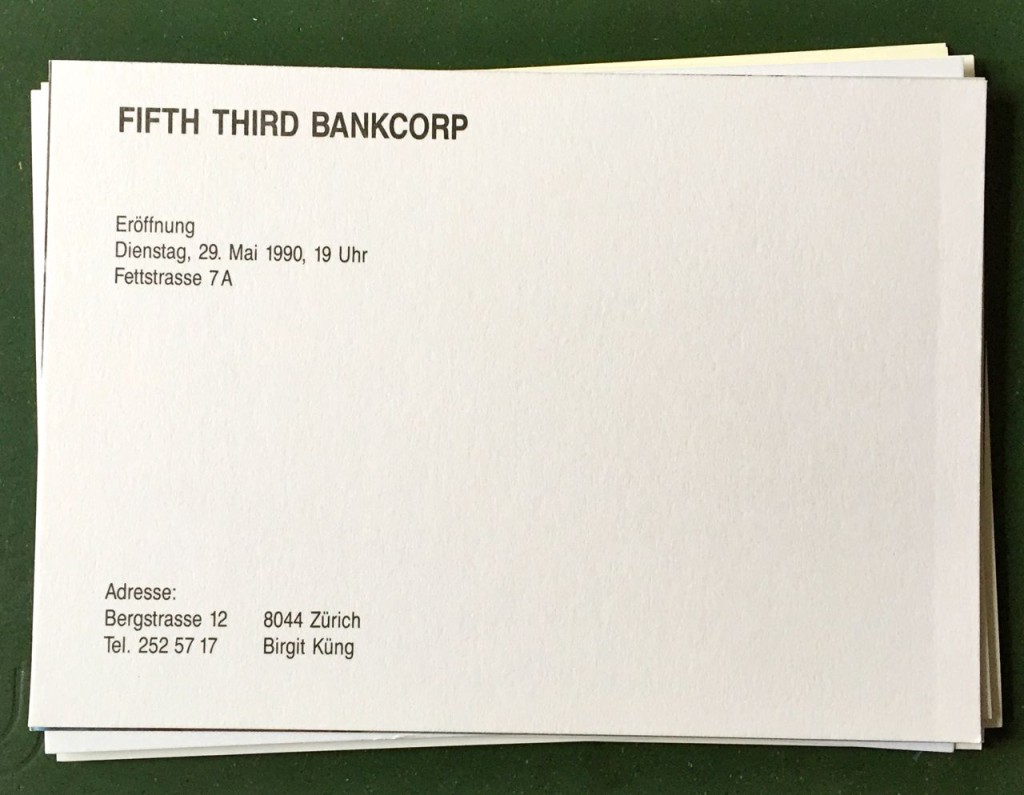
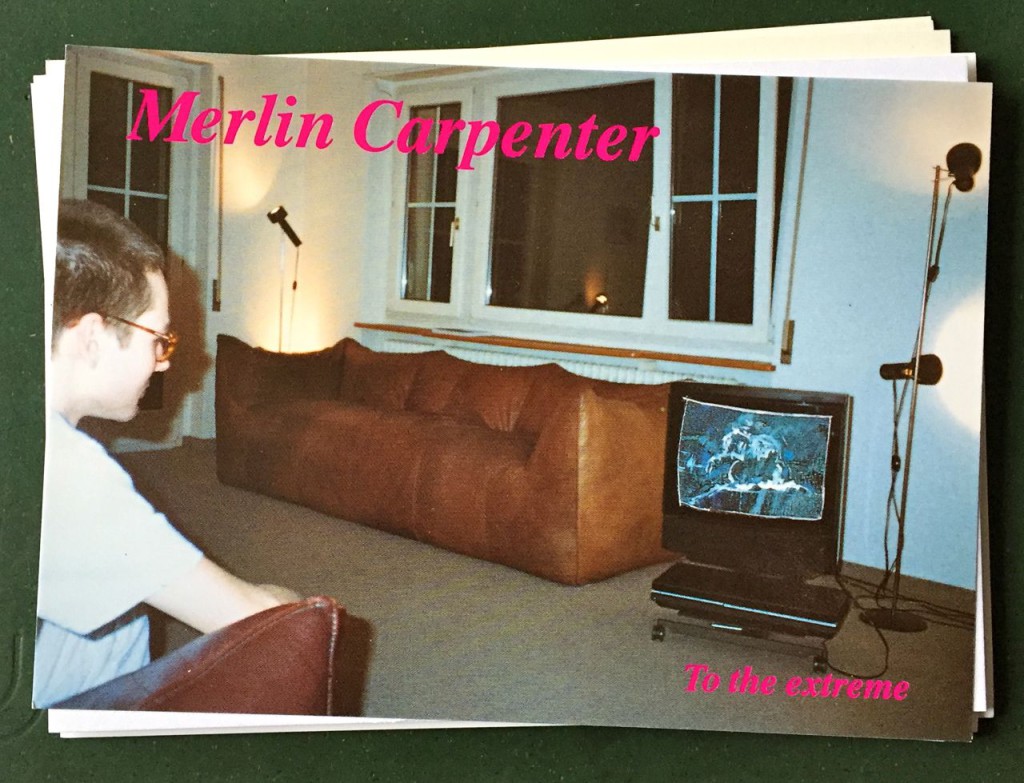
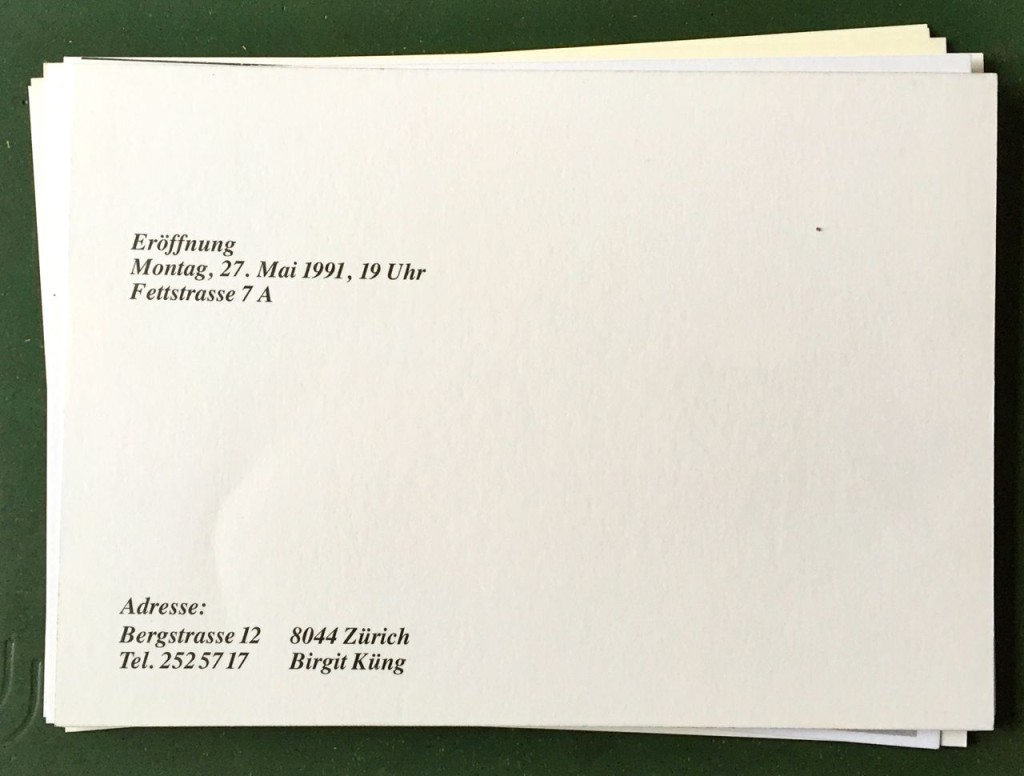
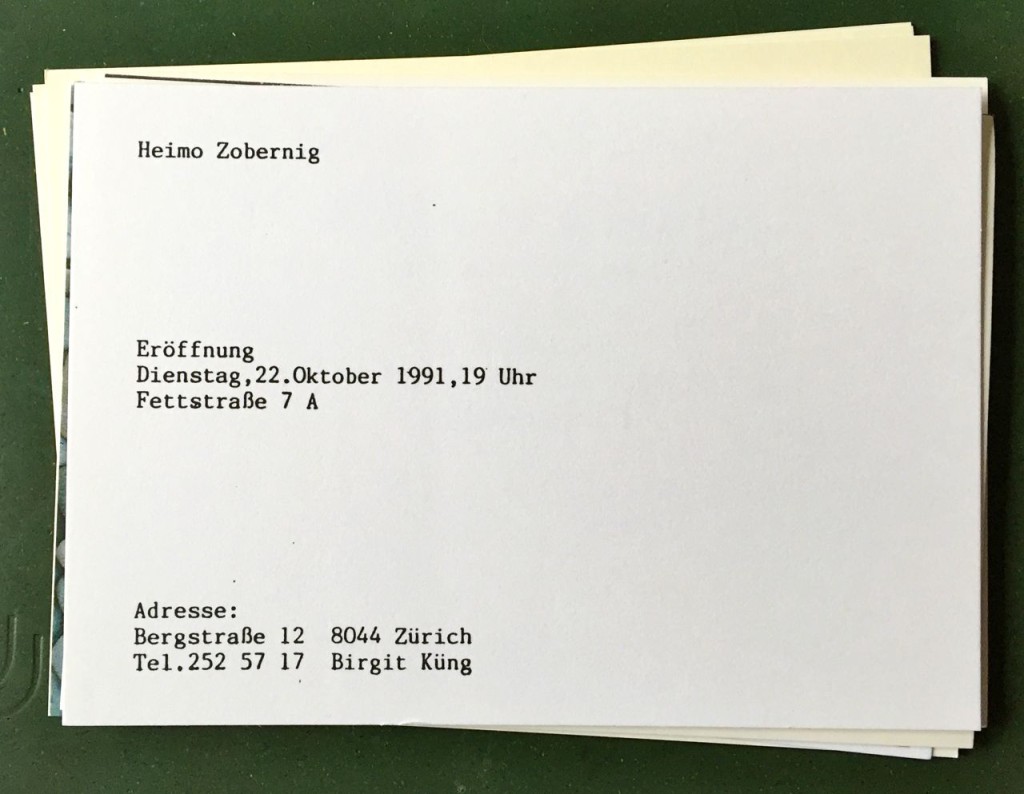
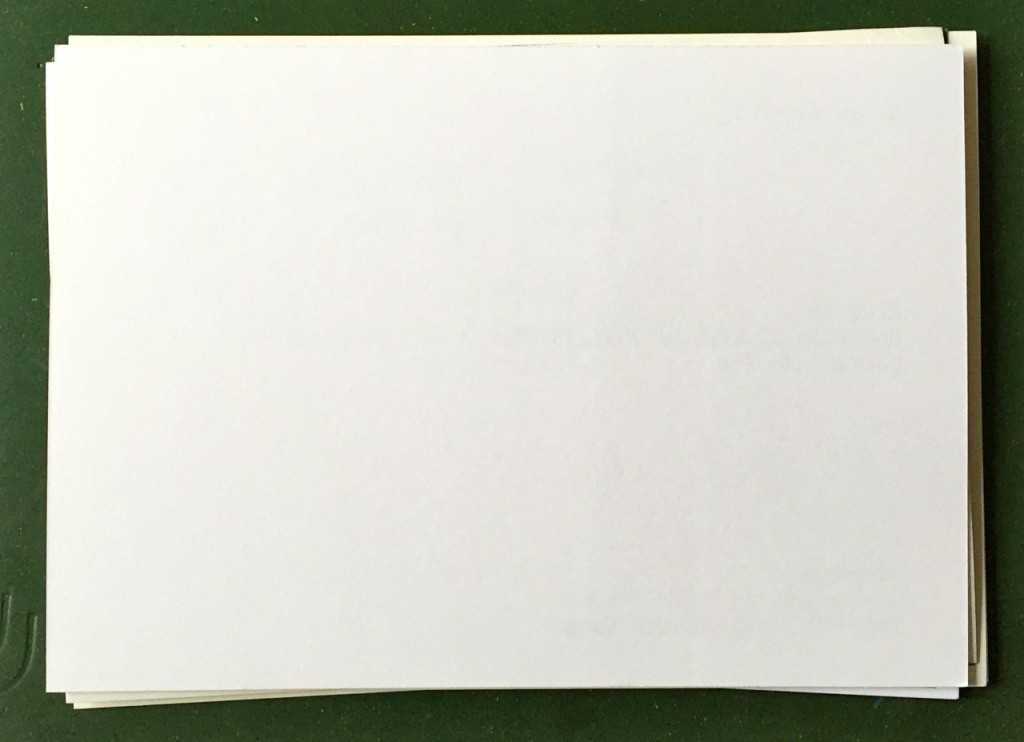
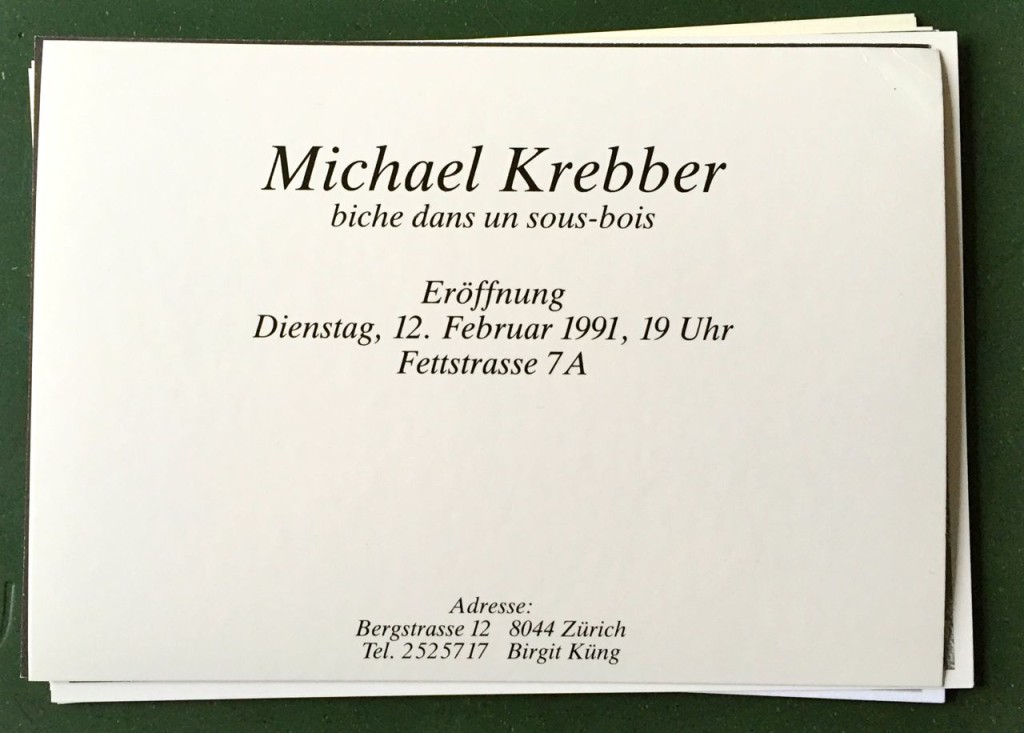
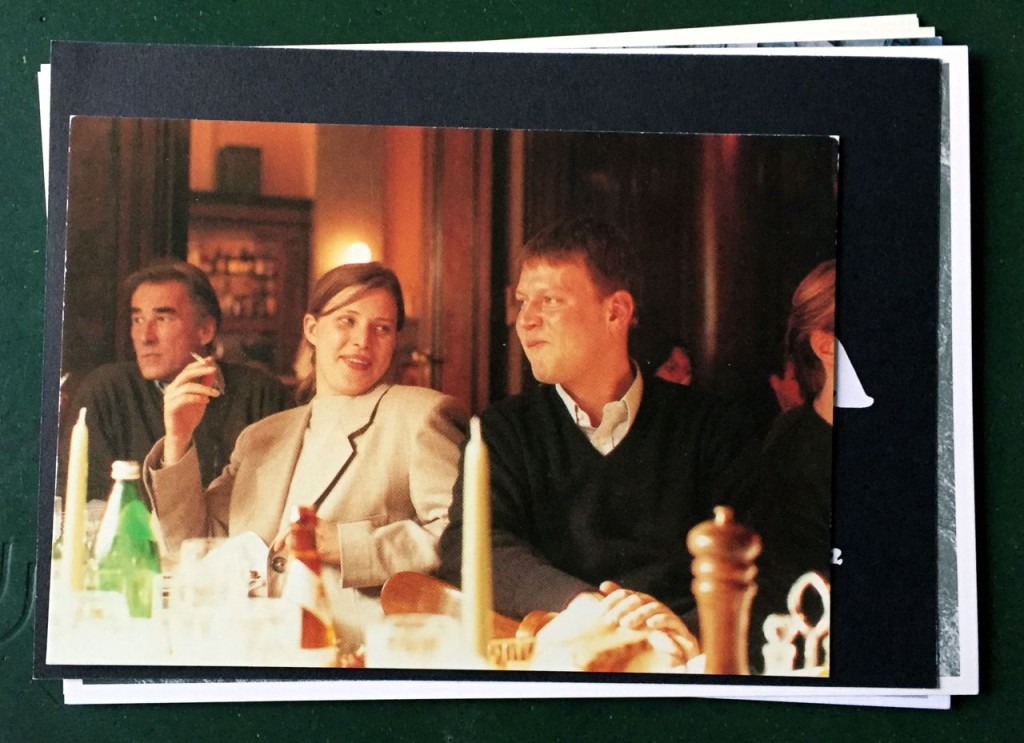
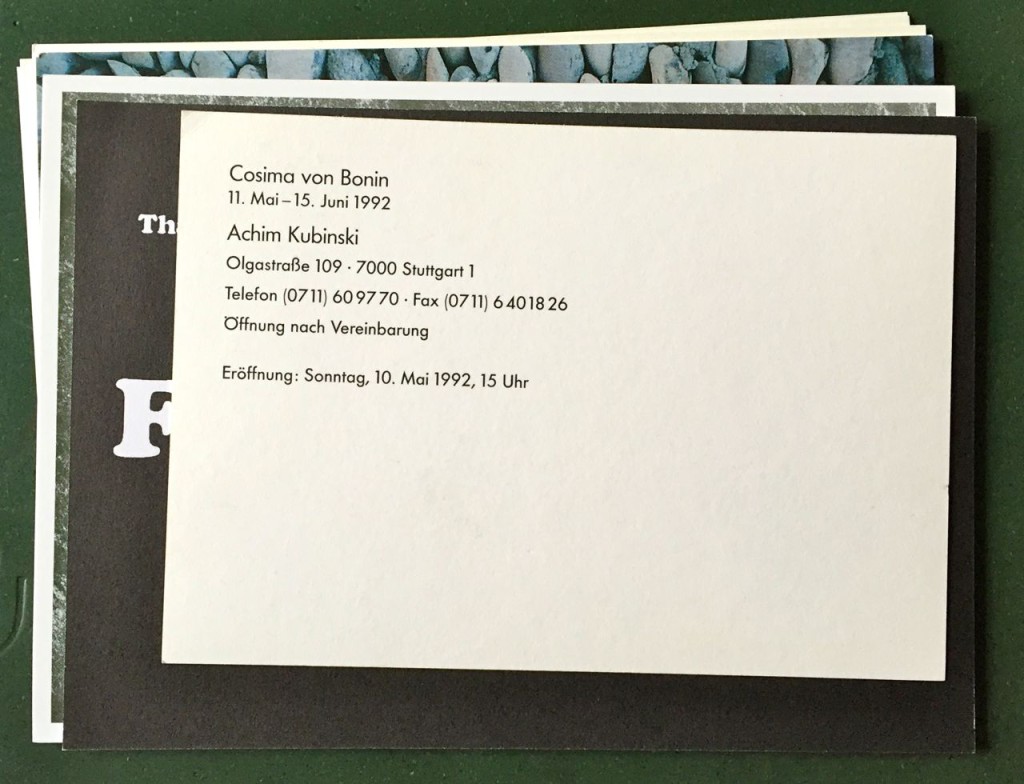
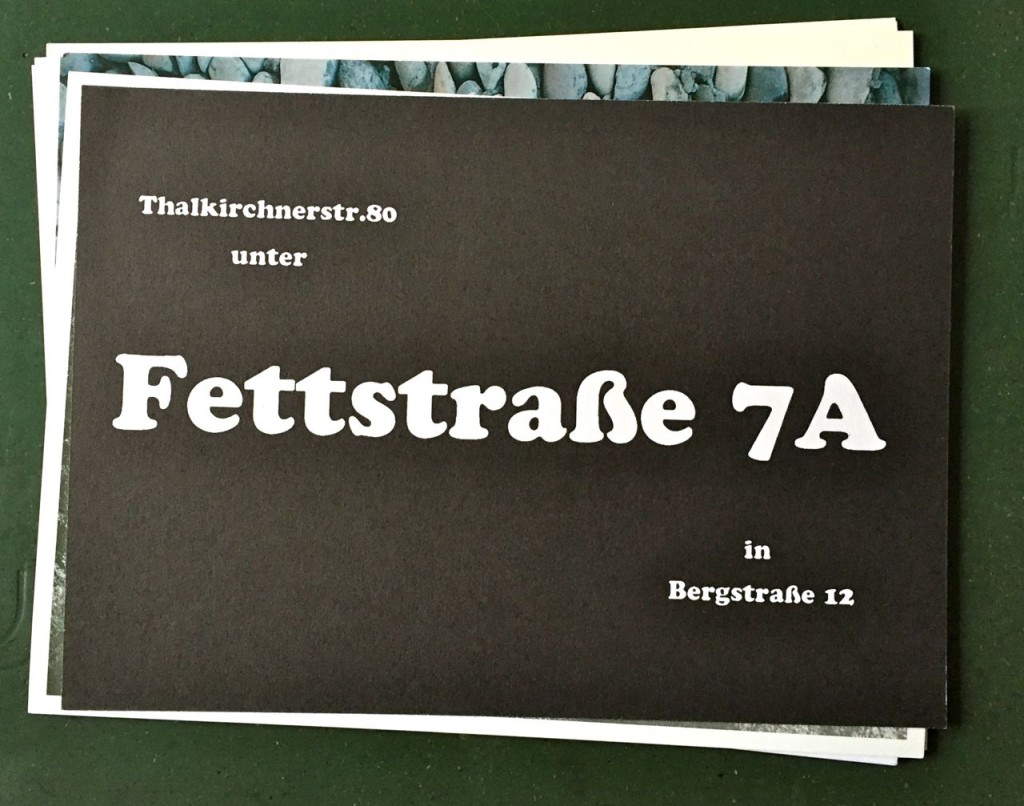
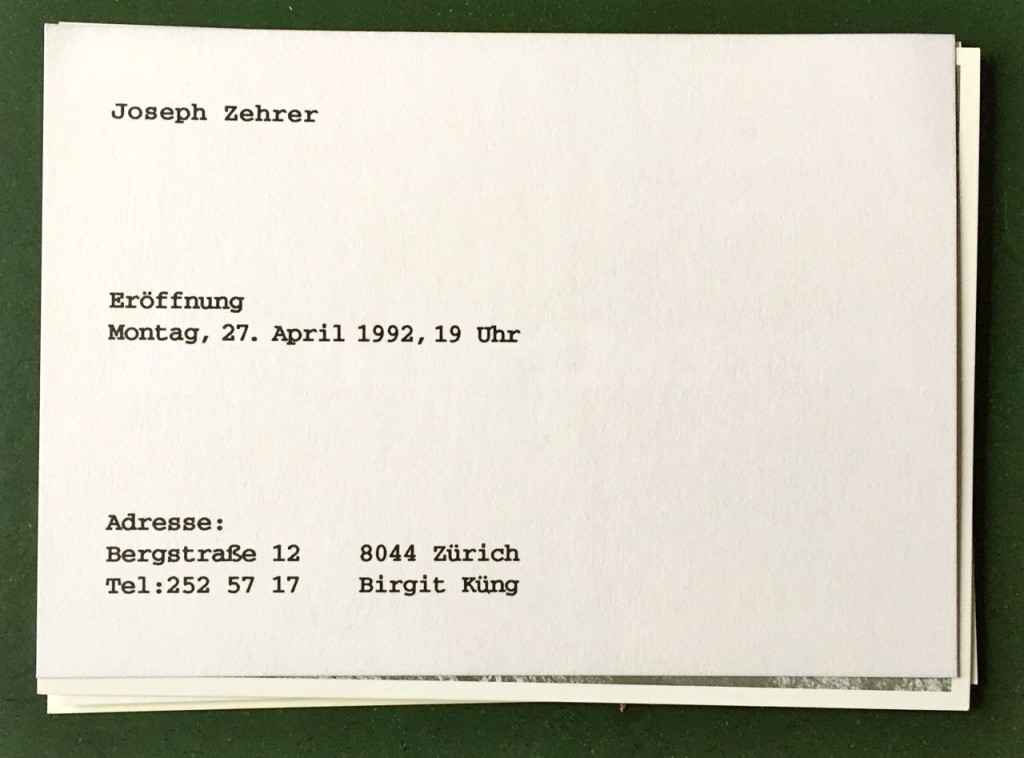
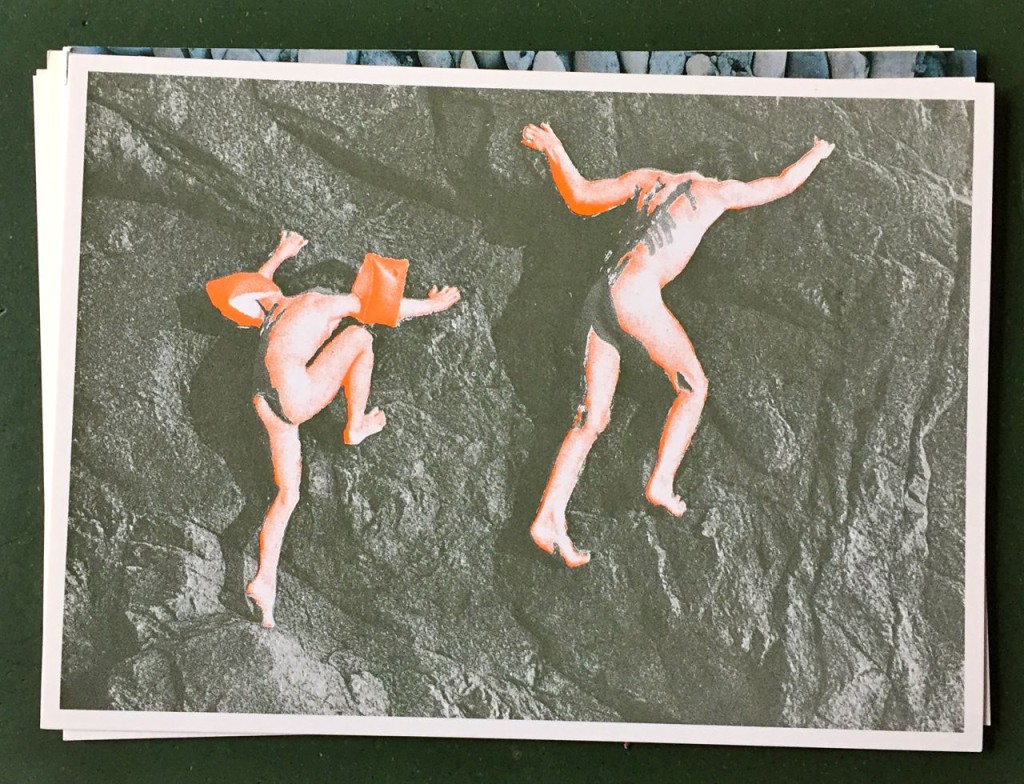
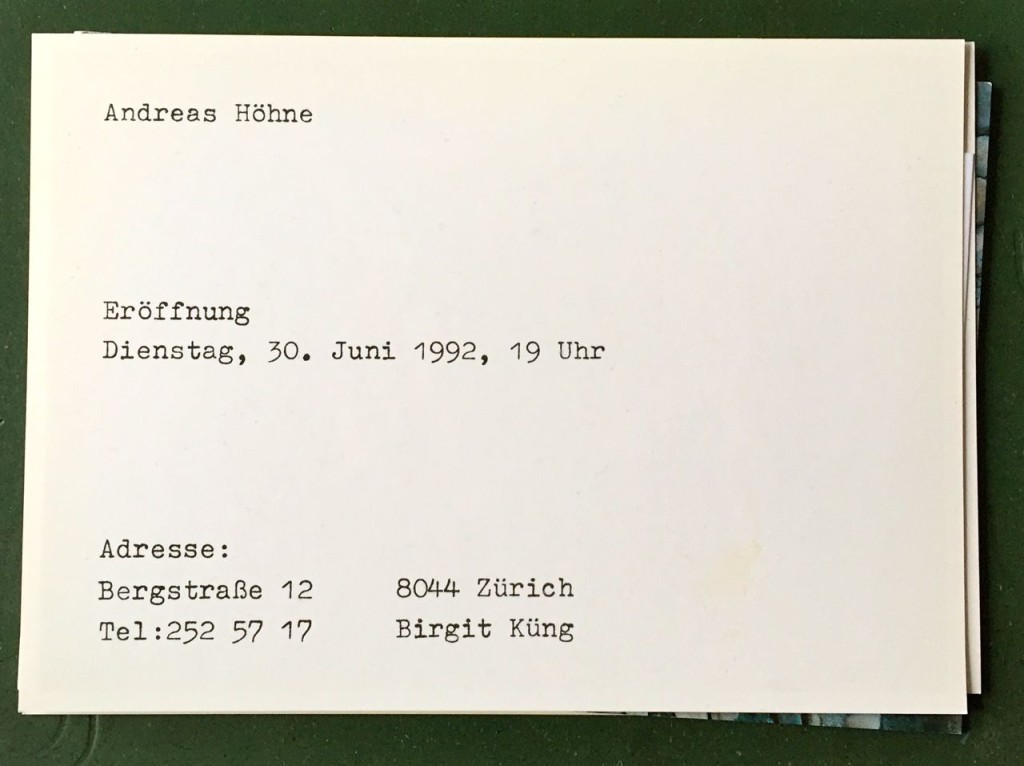
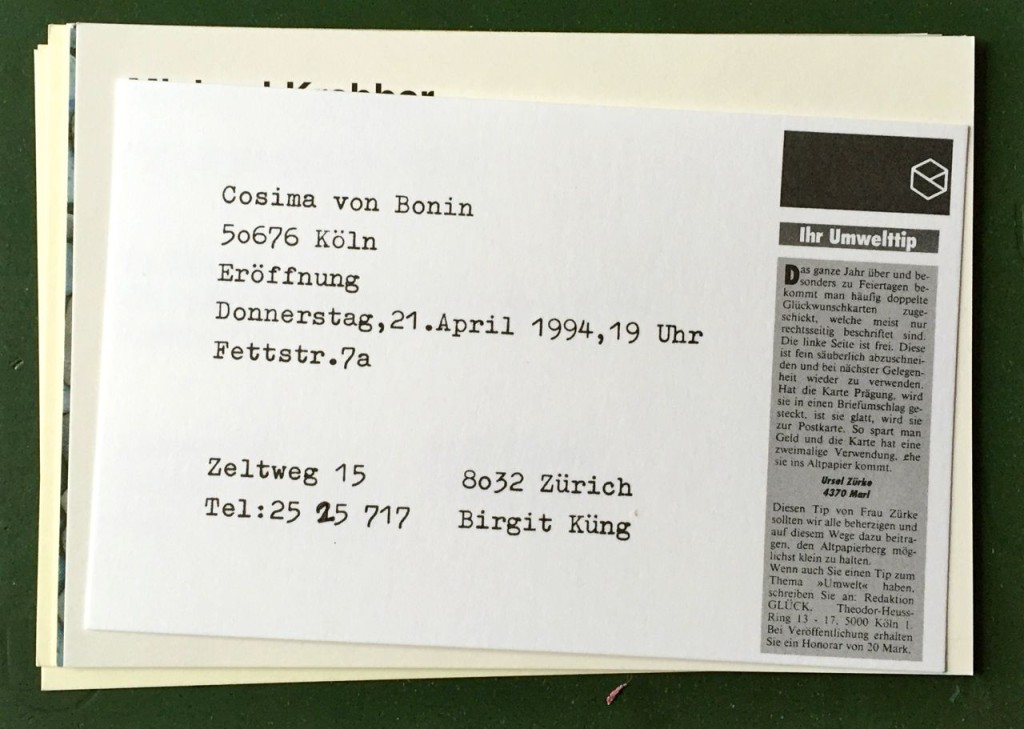
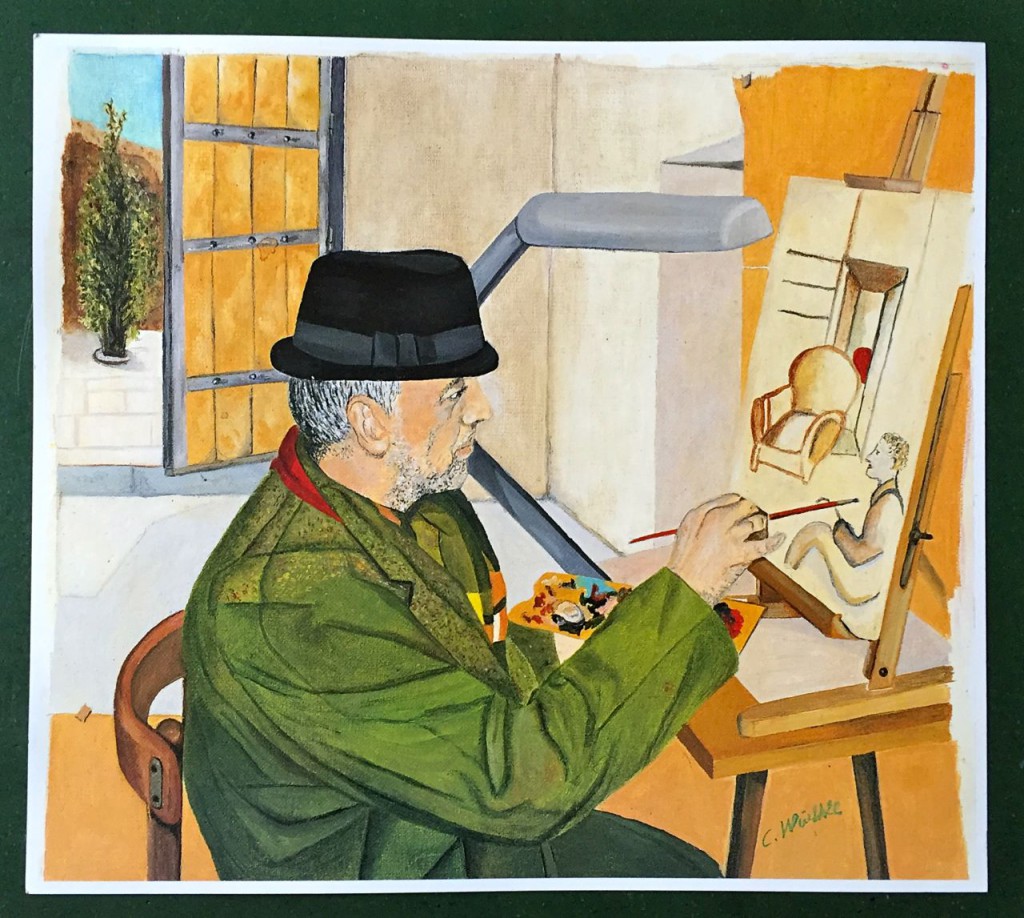
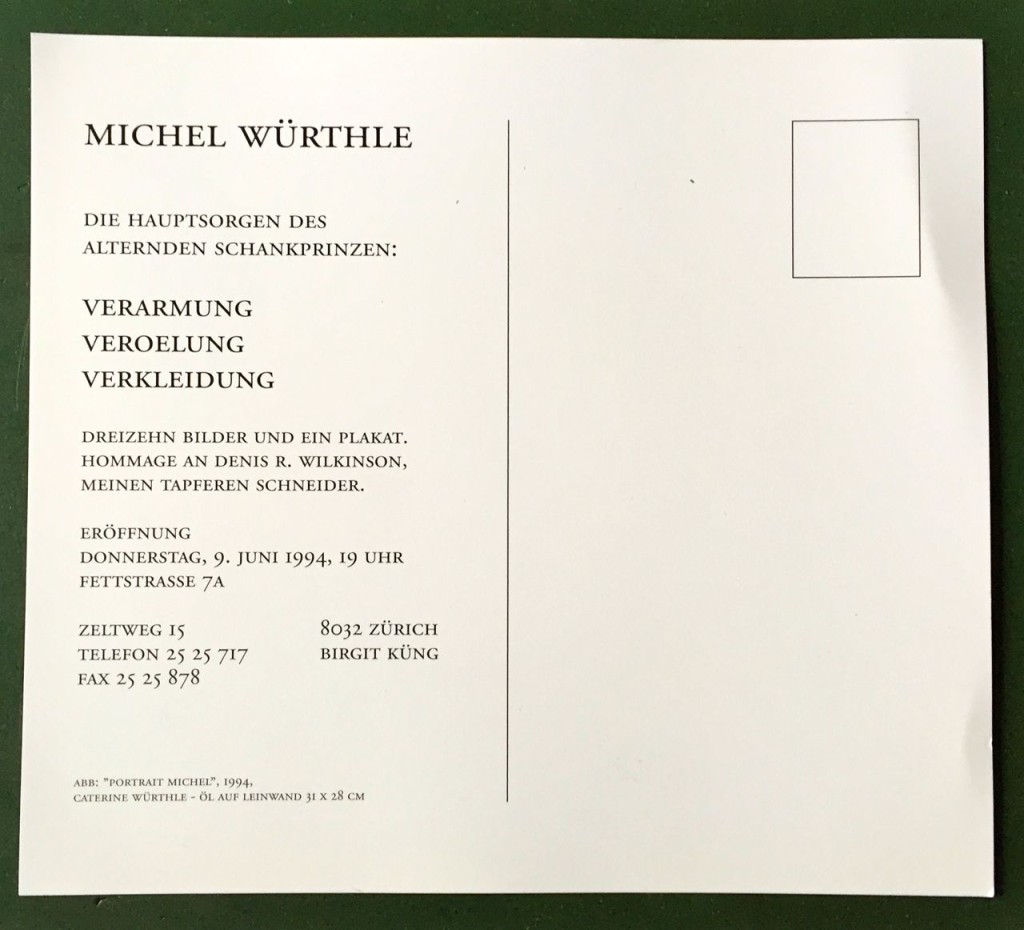
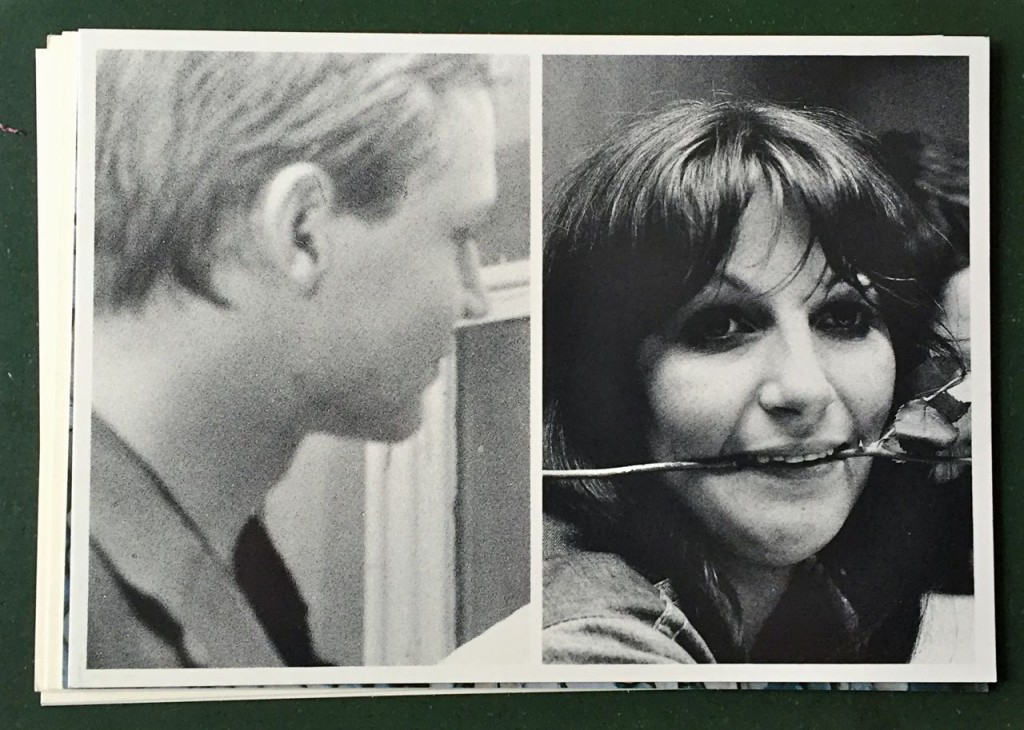
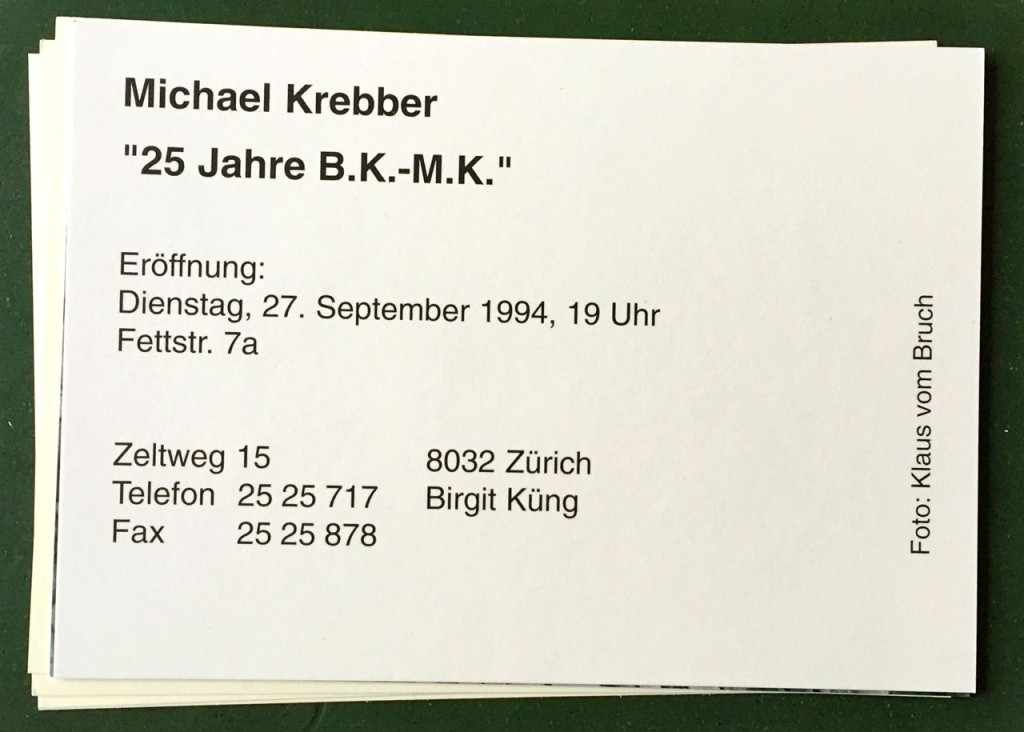
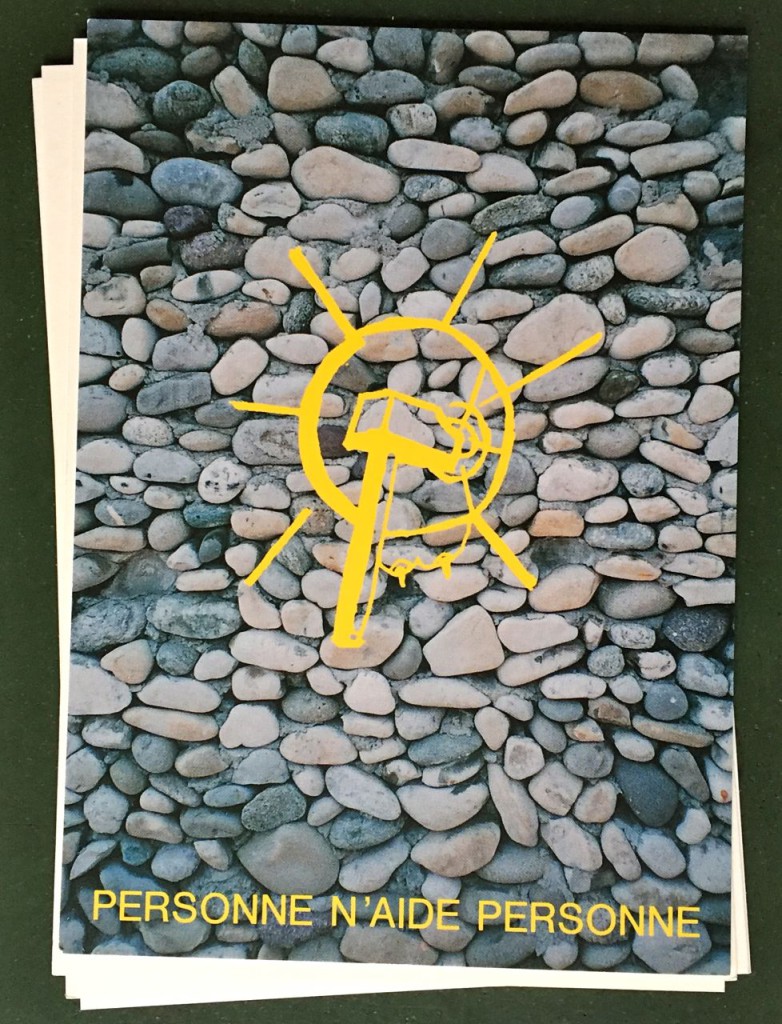
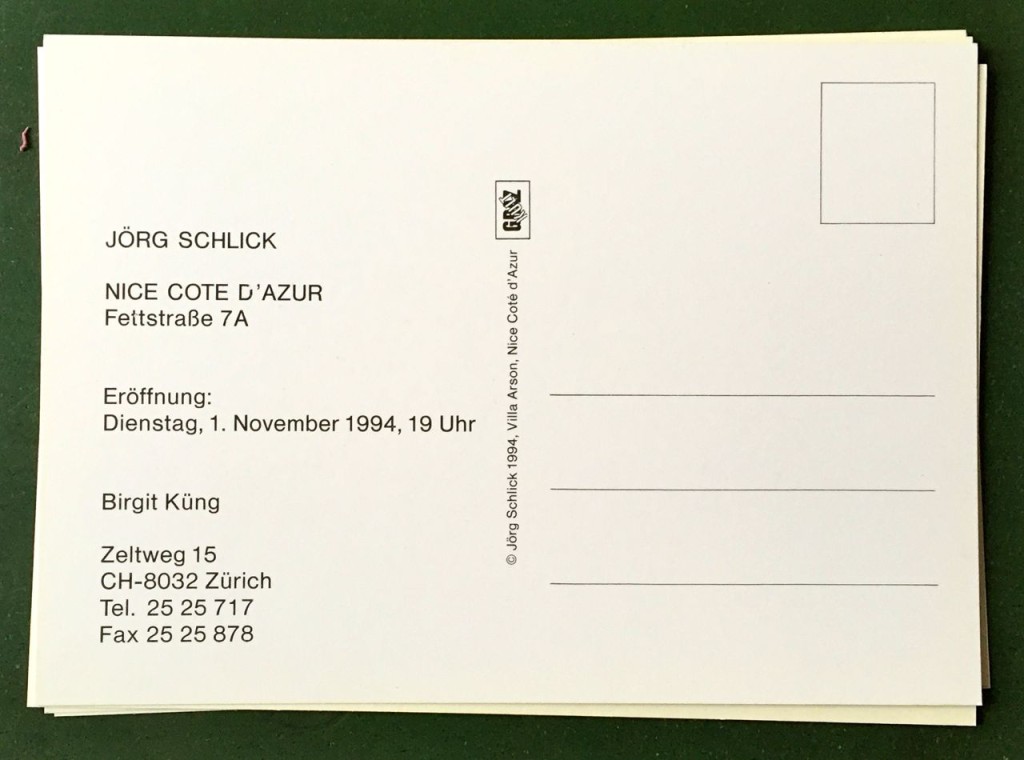
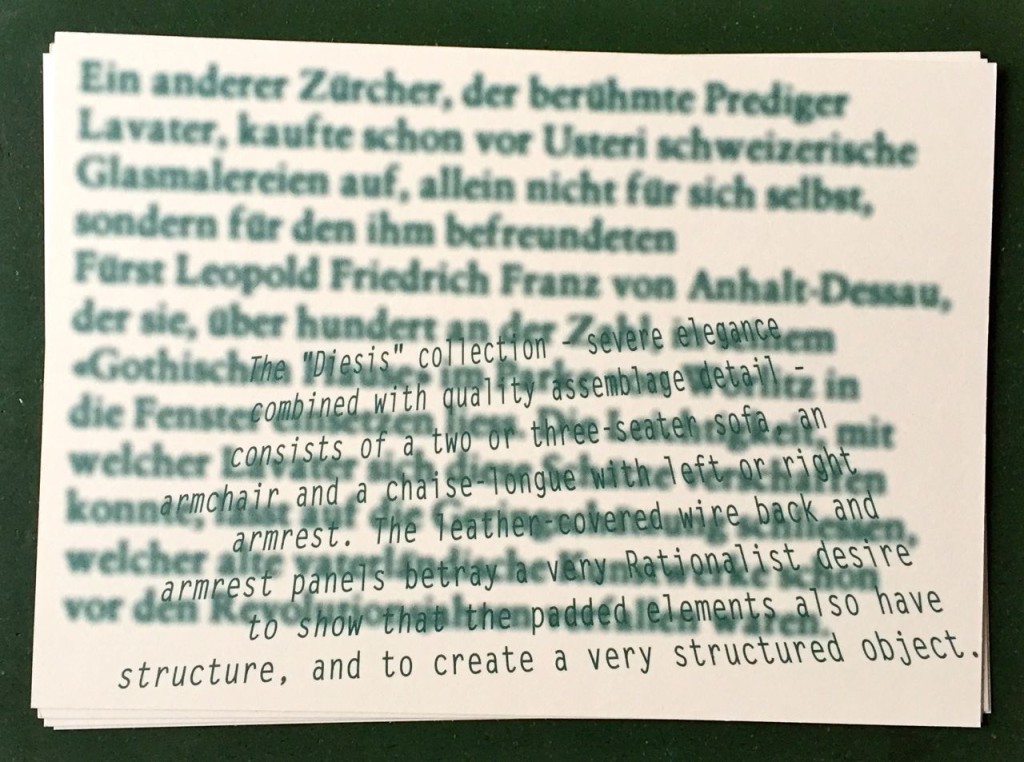
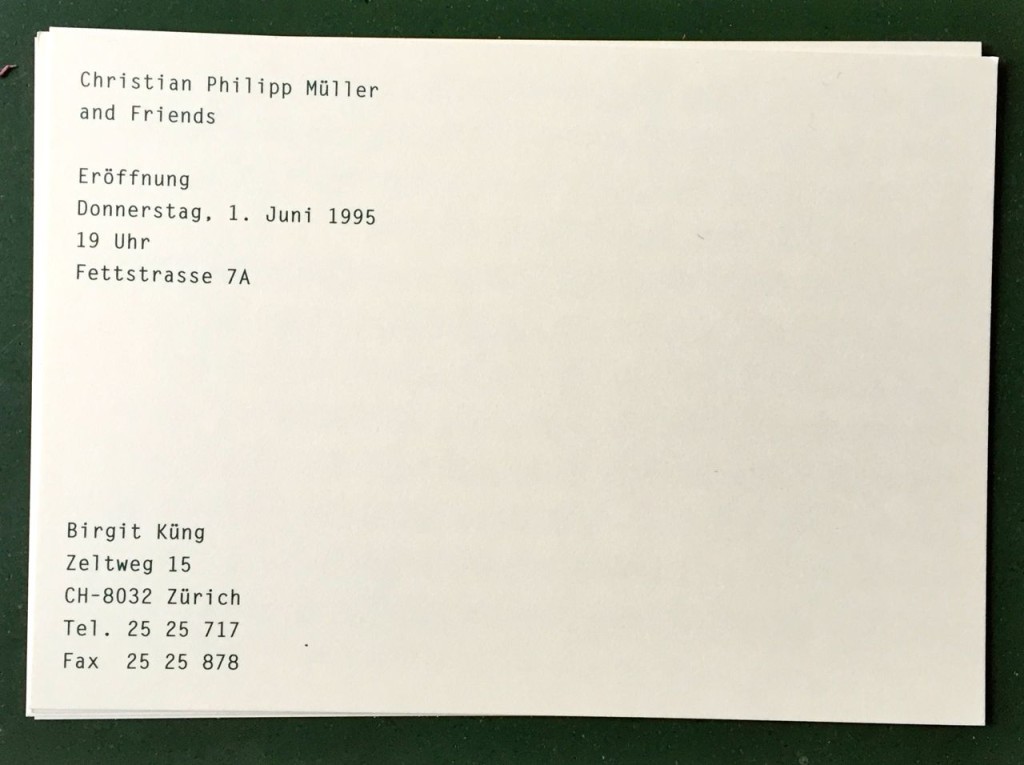
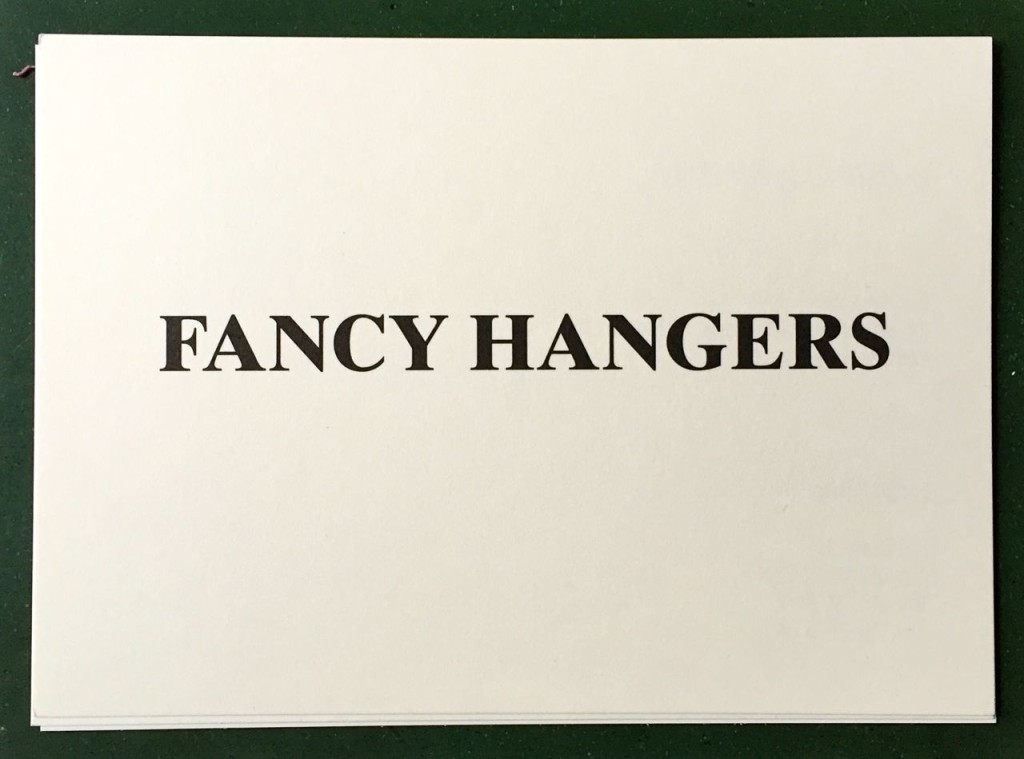
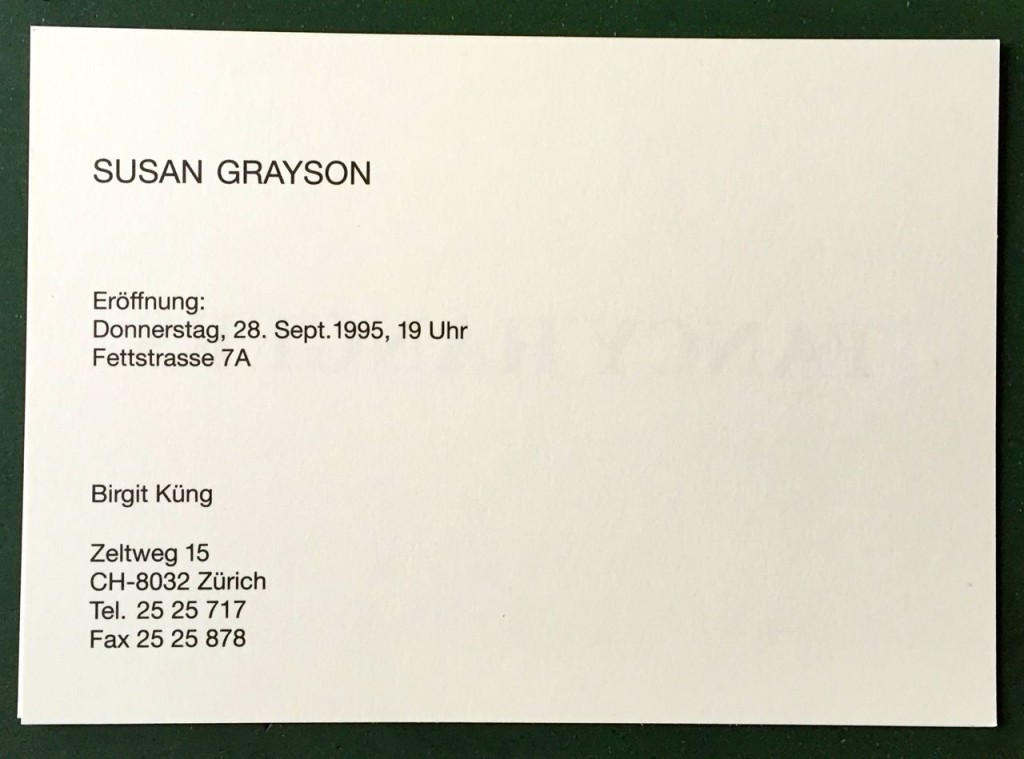
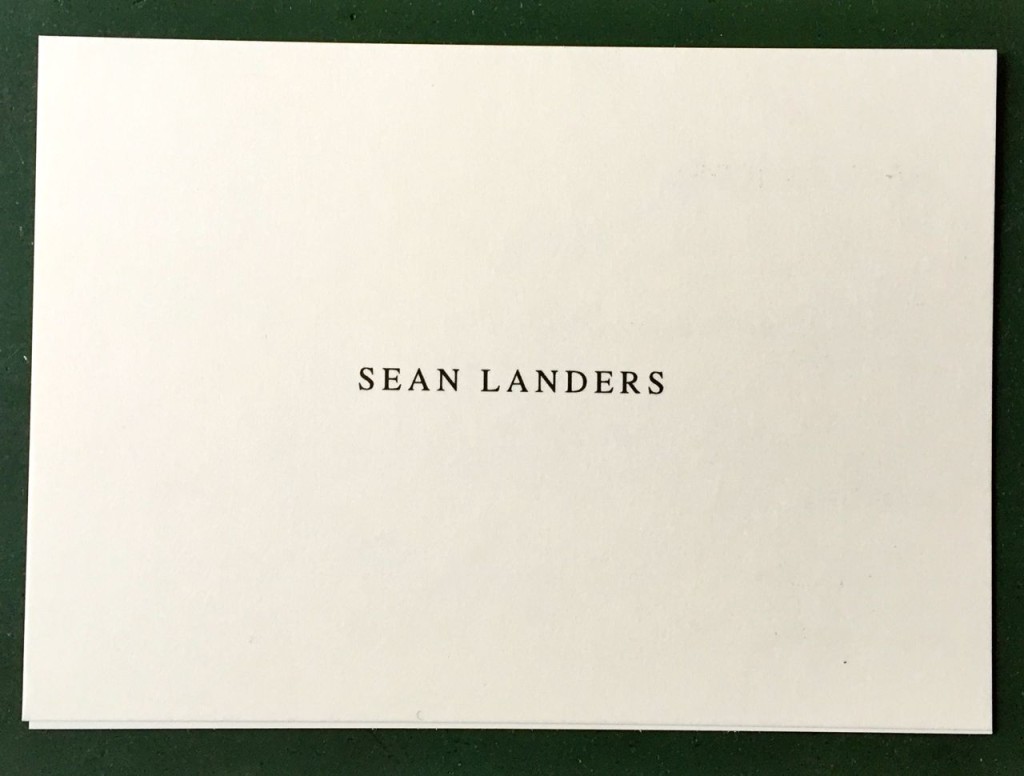
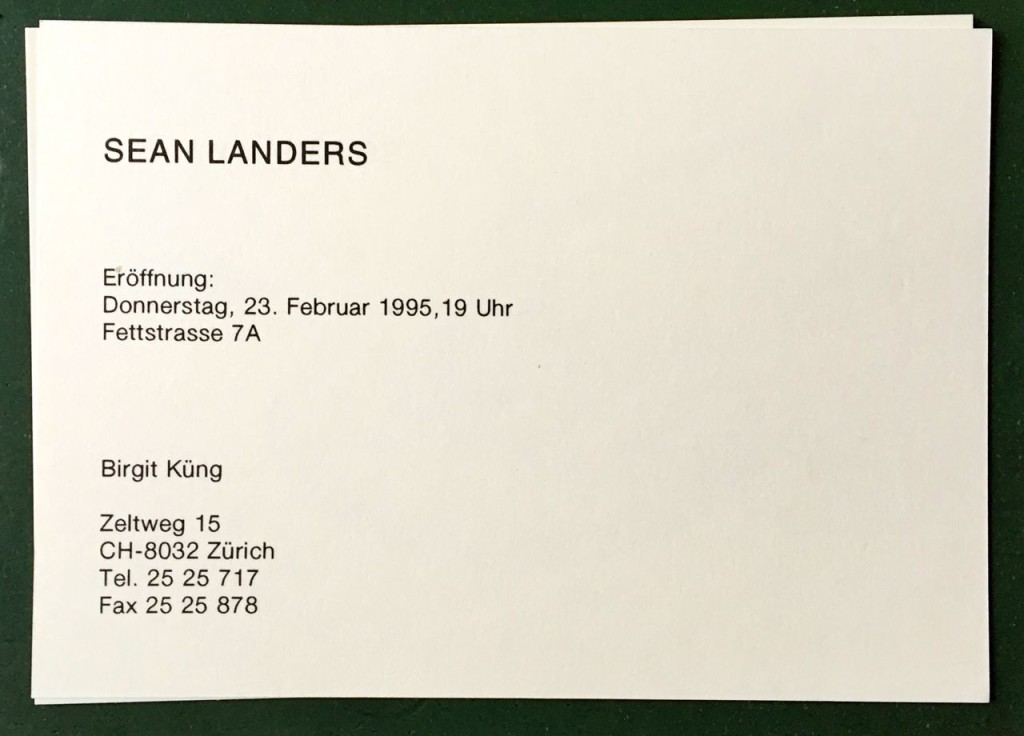
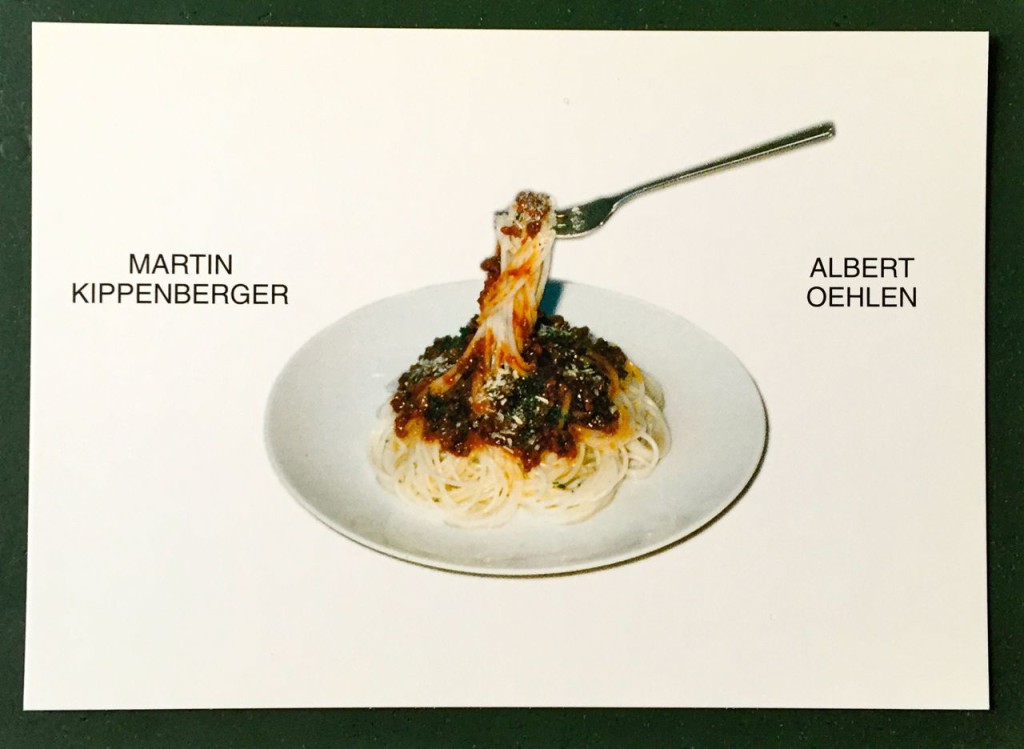
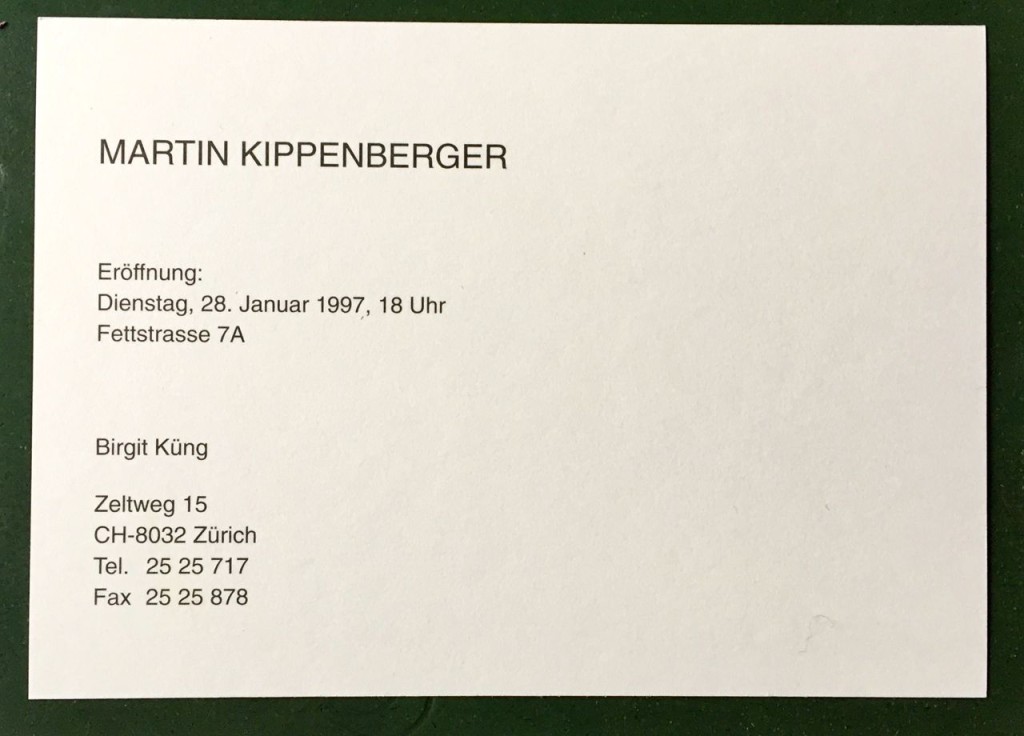
Fettstrasse 7a ist Zürichs wichtigste unbekannte Galerie, gegründet von Birgit Küng (zuerst Bergstrasse 12, dann Zeltweg 15). In den 1990er Jahren zeigte sie dort u.a. Cosmia von Bonin, Merlin Carpenter, Sean Landers, Martin Kippenberger, Michael Krebber, Albert Oehlen, Markus Oehlen, Michel Würthle, Heimo Zobernig. Der Zürcher Sammler Christoph Schifferli hat uns diese Einladungskarten zur Verfügung gestellt. Online findet man keine Informationen, falls Sie mehr dazu wissen, schreiben Sie uns bitte auf info-at-kunsthallezurich.ch. Besten Dank, Daniel Baumann
Randbemerkung 1. Fettstrasse 7a war meines Wissens ein Ausstellungsraum von Martin Kippenberger und Albert Oehlen in Hamburg in den 1980er Jahren.
Randbemerkung 2. Für mehr Kontext, Infos und Erhellung dieses Buch kaufen: Gina Bucher. Female Chic. Thema Selection – Geschichte eines Modelabels. Edition Patrick Frey, Zürich 2015
Randbemerkung 3: Bice Curiger schreibt am 17. Dezember 2015 per email:
“Birgit hat in der Galerie von Susan Wyss gearbeitet in den 80ern. Dort hat Kippi (Martin Kippenberger) auch ein wunderbares Plakat mit (dekonstruierter) Schweizerfahne gestaltet, basierend auf einem Objekt, das in der Ausstellung war. … Birgit hatte ja vorher an der Bergstrasse gewohnt, wo Heimo Zobernig einmal als Ausstellung den gesamten Spannteppich im Salon schwarz bemalt hat. Es sah eigentlich grauenhaft aus, verklebt und unappetitlich 😉 aber unvergesslich!
Persönlich bin ich stolz, dass ich Birgit 1974 anlässlich meiner ersten Reise nach NY kennengelernt habe. Sie lud mich zu sich zum Sonntags-Brunch ein, wo ein schmächtiger, sehr verkaterter Deutscher sass. Man hat ihn mir nicht vorgestellt, aber nach und nach merkte ich, dass es Blinky war, ja, der, Blinky Palermo. Wir fuhren dann alle mit der U-Bahn nach Harlem, wo wir einem Gottesdienst von Reverend Ike im United Palace Theatre beiwohnten…”
Cy Twombly, 1971
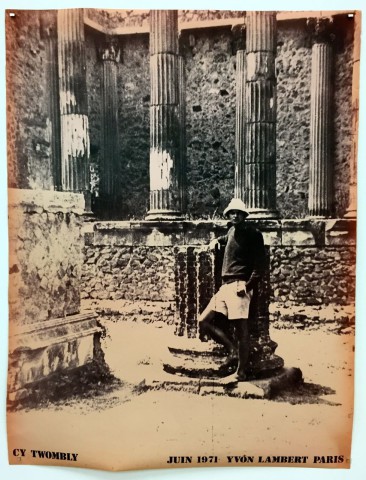
Rosalind Krauss, “Cy was here; Cy’s up,” in ArtForum, September 1994
Who’s Right? So who’s right, do you think? Roland Barthes, or all the others who’ve written about Cy Twombly–all those for whom the Latin is serious, to be taken at face value, consumed as erudition, as classical humanism somehow magically surviving amidst the barbarism of the late 20th century, a talismanic flower sprouting from a decaying Roman wall? Here that view is in its most sick-making, obsequious form, written by Twombly’s assiduous art-historical amanuensis, the Heiner Bastian who is compiling the catalogue raisonne of the paintings, the drawings, the sculptures, the prints. Bastian asks,
Who speaks through Venus and Mars, Amor and Psyche, Leda and the Swan, Achilles and Patroklos, through Achilles’ grief and vengeance, through Eros’ punished desires, through Orion’s blind fate, through Diana, Flora, Theseus, Galatea’s triumph, through Keats’ Adonais, through Sesostris’ sun journey, through Aurelius Commodus’ madness, through Catullus, through Caesar’s Ides of March: mirrors of masks as in Twombly’s identification of Apollo and Mars with the Apollonian and Dionysian principle, as indelible horizon. In The Veil of Orpheu the song of all that is changed, magic moment like the evening over Arcadia. Veil over the song awakening to tears the shades of the dead. Veil, time line and changing context in everything that can be captured as poetry in painting.(1)
For Barthes, it’s clear that if the answer to that question is that it’s Cy Twombly who speaks, it’s just as clear that he can’t be speaking straight. Barthes insists that Twombly’s graphisms, more those of the schoolboy than of the erudite, only allude to writing, before going off somewhere else. “When TW writes,” Barthes says, having decided to refer to Twombly via his own invented cipher for the artist’s name, “and repeats this one word: Virgil, it is already a commentary on Virgil, for the name, inscribed by hand, not only calls up a whole idea (though an empty one) of ancient culture but also ‘operates’ a kind of citation: that of an era of bygone, calm, leisurely, even decadent studies: English preparatory schools, Latin verses, desks, lamps, tiny pencil annotations. That is culture for TW: an ease, a memory, an irony, a posture, the gesture of a dandy. “(2)
Pictorial Nominalism. And what does the name “call up”? For all the other commentators the name signals analogy, the likeness of the thing thought to be found on the surface of the painting. It functions, that is, as the title of the traditional painting: it says, “Here is . . .” as in, Here is the rape of the Sabines, the flight into Egypt, Judith beheading Holophernes. They believe that if it is written Sunset (as on School of Fontainebleau, 1960), then “Here is a light-filled landscape,” and they rush to fill in–in their imaginations, but also on the canvas onto which they project them–the places where they know Twombly has stayed: the Lake of Bolsena (although they always say the Lago di Bolsena, since that sounds so much sunnier, so much more Italian), the island of Ischia, the hills of Rome. They fill in whole narratives, as in the going mad of Aurelius Commodus, or the transformation of Narcissus. Representation, they think, is everywhere.
Barthes is clear that Twombly’s art does not work by analogy. The name is pronounced, in fact, despite the fact that there is no vista, no Virgil, no Leda and the Swan to be found except as scrawled words. “In Twombly’s titles, we must not look for any induction of analogy,” he says. “If the canvas is called The Italians, do not look for the Italians anywhere except, precisely, in their name.”(3)
Further, Barthes knows that if the inscription, the “pictorial nominalism,” does not operate the terms of analogy (mimesis, representation, likeness), it has another type of function, one he locates along the axis of the performative.(4) The performative is found in its purest form in those of Twombly’s paintings that function as dedications: To Valery, To Tatlin. The performative is a modality of language where meaning is identified with the very performance of the statement–as in “I arrest you,” “I pronounce you man and wife,” “I promise,” “I swear,” “I toast.” It is thus a linguistic operation in which reference is suspended in favor of action: not meaning something, but doing something. It is the nexus through which representation is transmuted into force (the very one Michel Foucault invoked when he moved in 1968 to associate knowledge and power, arguing that sequestered within every seemingly neutral historical narrative was the discursive axis of the performative’s relations of authority. Hence his decision to mark the field of power by calling it discursive, and its scholarly accounts, discourses). Even when Twombly is not actually “dedicating” a work, when he is instead only idly doodling a name on his canvas–Leda, Mars, Bolsena–he is operating within the field of the performative: I mark you, I name you, I call you “painting.” This is the big difference, the difference amounting to an absolute rupture of discursive intent, between the notion of the performative and that of analogy.
The others are determined to maintain analogy. Bastian insists that “Twombly sees the object and the sign that stands for it as a simultaneous unity that arises in the act of drawing,” with the result that “his gesture and the breath of emotion suffuse the volatile ductus of all his forms.”(5) Roberta Smith maintains that “on virtually every canvas, Twombly spells out what he has also painted and drawn.”(6) Spotting “the rapidly made vertical marks along the bottom edge of an untitled work done in Rome in 1959,” which appear on either side of the scrawled name of the town Bolsena, she elaborates what she takes to be the mimetic puzzle: “These marks could indicate blades of grass,” she says, “or equally credible, some method of counting or keeping track, such as marking off the days. They are also dotless exclamation marks, signals of an intense but unspecified emotion, whether joy or anger.”(7) It never occurs to Smith that it is precisely this form of semiological overkill, in which she moves from one “looks-like” to another, that has the effect of undoing semiosis, of scattering and disrupting analogy, acting to perform a violence of the mark that Jacques Derrida would call dissemination: the mark reconsecrated as performative.
An Arena in Which to Act. All the others are not only welcoming analogy but seeing it already prefigured in those works to which Twombly succeeded, as rightful heir. He and Robert Rauschenberg and Jasper Johns perform, in their eyes, a sublation of Action Painting, canceling its abstract insularity but preserving its emotional intensity, and thus continuing an art of expressiveness, revealing therein Abstract Expressionism’s own proclivities toward representation, toward landscape (Jackson Pollock), toward the body (Willem de Kooning).
But this, I would say, is a massive misunderstanding, a refusal to acknowledge the implications of Twombly’s means, the medium he adopted in 1953 and had perfected by 1955, the medium through which he drew his own conclusions about the import of Abstract Expressionist gesture. Turning away from an imitation of the smears and scumbles of Franz Kline or de Kooning, which he had been practicing at Black Mountain College, Twombly took up graffiti as a way of interpreting the meaning of Action Painting’s mark, and most particularly that of Pollock’s radically innovative dripped line. For graffiti is a medium of marking that has precise, and unmistakable, characteristics. First, it is performative, suspending representation in favor of action: I mark you, I cancel you, I dirty you. Second, it is violent: always an invasion of a space that is not the marker’s own, it takes illegitimate advantage of the surface of inscription, violating it, mauling it, scarring it. Third, it converts the present tense of the performative into the past tense of the index: it is the trace of an event, torn away from the presence of the marker. “Kilroy was here, it reads.
In this sense graffiti makes clear that the idea of the painting as the mirror of the painter–an idea suggested by Harold Rosenberg’s theory of Action Painting–is an impossible utopia, the dream of an art of presence. Even as graffiti’s graphic lash strikes in the present, it registers itself as past, a mark whose violence dismembers the very idea of the image in the mirror, the whole body, Narcissus. Graffiti’s character (Barthes would say its genius) is the strike against form, ensuring a field in which the only way the image of the body can survive is as part-object, a concatenation of obscene emblemata, the genital splatter that Twombly went on to enact in his Roman paintings from the early ’60s.
It is true that Twombly’s works announce a connection to Pollock. He makes this unmistakable in 1955, with Panorama, in which he drives home the lesson of the white paintings from the same year, breaking up the loops and scrawls of the large aimless marks into a more connected “allover” lattice, producing a kind of graffiti/skein at a monumental scale. This bow to Pollock in the regularizing and making rhythmic of the nonetheless violent mark is there as well in Panorama’s reprise at the end of the 1960s in the “blackboard” paintings, beginning with Night Watch. But this connection is not an “influence,” it is a “reading,” or, rather, what Harold Bloom would call a strong misreading, and thus a way of declaring how Pollock’s work should be read, at least in Twombly’ eyes. Twombly “misreads” Pollock’s mark as graffiti, as violent, as a type of antiform. And this misreading becomes the basis of all of Twombly’s work.(8) Thus he cannot write “Virgil” on a painting and mean it straight. “Virgil” is there as something a bored or exasperated school-child would carve into a desktop, a form of sniggering, a type of retaliation against the teacher’s drone.
And who is the teacher in this parable? Let us imagine him as Robert Motherwell under whose “patronage” Twombly made one of his earliest public appearances.(9) The Motherwell of Mallarme’s Swan and of the complete works of Garcia Lorca was ever happy to sell Abstract Expressionism out to classical humanism, to lay claim to “philosophy” and to “literature” by means of gentrifying every loop an every splatter. This Motherwell who had the cheek to muscle in on Pollock’s invention and to try to share in its inception, this narrator to whom Robert Hare referred as “the Humbert Humbert of 94th Street,” wanted to domesticate Pollock, to make his work over into a lesson in symbolist lyrics.(10) It is this leading Twombly seems to protest with every means at his disposal. To rewrite Mars as M/ars is to make the deflationary, scatological, schoolroom joke: “Mars = m … arse.” Every French second-grader wants to volunteer to spell the name of the town of Apt: “Ah-pe-te,” they say, sputtering with laughter: “[il] a pete,” he has farted.
It is this deflationary gesture that Barthes sees as crucial to getting Twombly’s tone. Yes, he admits, the Mediterranean light is there, as are the silence and the emptiness. And yes, there is a chain of references inscribed on the canvases that leads from antiquity to the present. He calls this the “Mediterranean effect,” and says that “Twombly’s inimitable art consists in having imposed the Mediterranean effect starting from materials (scratches, maculae, smears, dearth of color, no academic forms) which have no analogical relation with the great Mediterranean radiance.” But he immediately adds that what takes place in each of Twombly’s works is an attack on seriousness, on decorum, one that “takes on the appearance of an incongruity, a mockery, a deflation, as if the humanist turgescence was suddenly pricked.”(11)
Who Says So? In the unanimity of opinion on Twombly’s “classicism,” his reverence for the art of the past, the obeisance he pays to tradition, etc., we suspect the hand of the master at work. Bastian is, after all, Twombly’s chosen mouthpiece, having published on his work since the early ’70s and having been consigned the task of gathering together the entire oeuvre. Bastian’s word is the voice of the artist passed along to us, as though by ventriloquy. So if Bastian says it is “a fundamental error” to think of Twombly’s mark as a form of graffiti, if he dismisses the latter as regressive and fetishistic, a collective lexicon standing “in crass opposition to the psychic activity of Twombly, for whom every line every sign is an expression of a deeply felt emotion or inner experience,” we know this to have been dictated by Twombly himself.(12)
Do we care? To what degree do we have to respect Twombly’s self-assessment, since it is certain that Twombly himself didn’t respect Pollock’s? To what degree is it our responsibility to make an independent reading of an artist’s work, acknowledging that while an artist may be a good interpreter of his or he own production, it does not follow that he or she will be its best one–no more than the analysand is the best reader of his or her dreams, motives, associations? To the contrary–the analysand is often the worst.
I have no idea which Twombly the Museum of Modern Art’s upcoming retrospective will celebrate. Twombly’s? Its own? A combination of the two? That it will be mine or Barthes’ is the least likely. But one can always hope.
{ Copyright Rosalind Krauss. Artforum International Magazine, Inc. 1994 }
Julie Ault – Afterlife
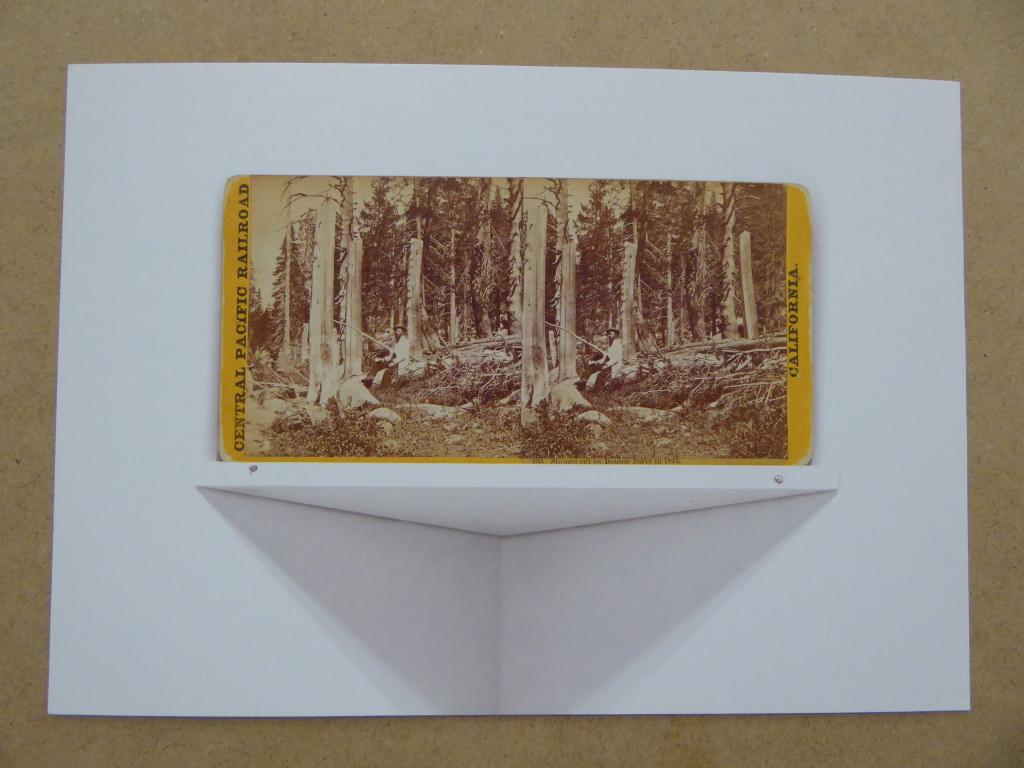
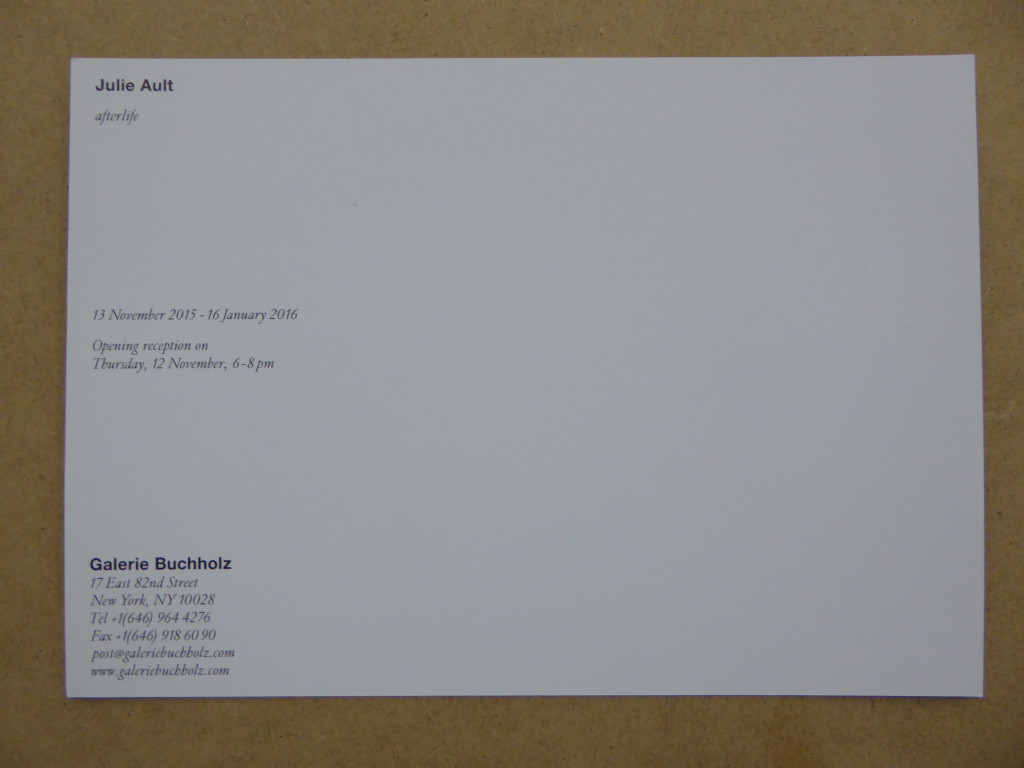
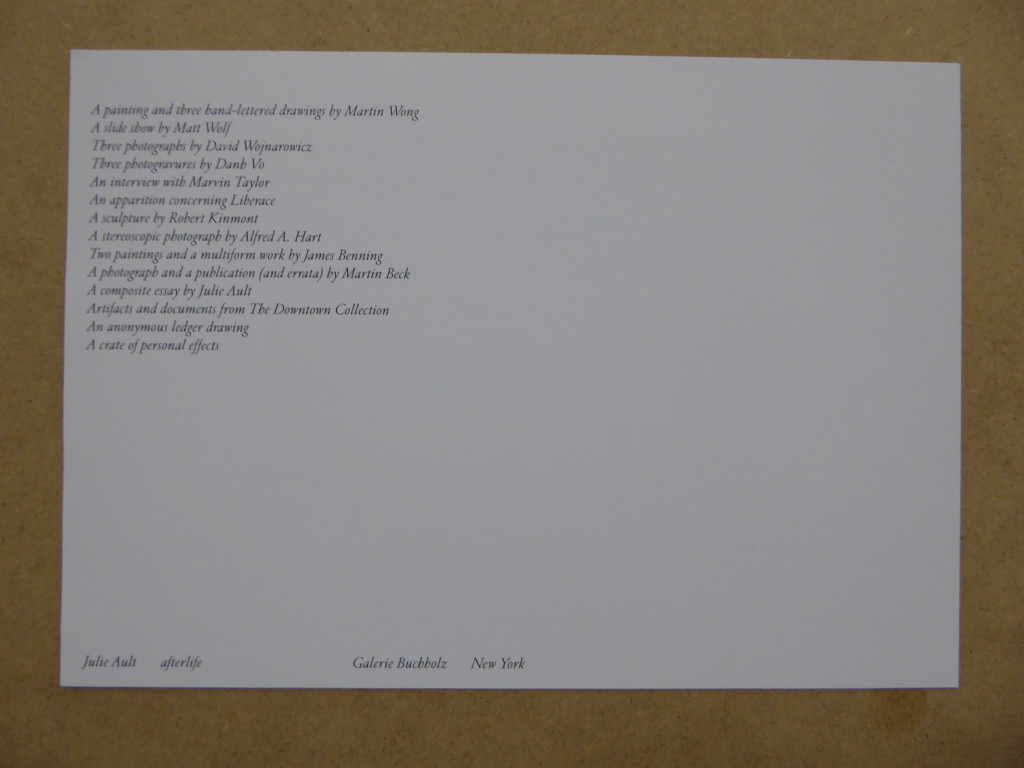
Elizabeth Peyton – Dark Incandescence
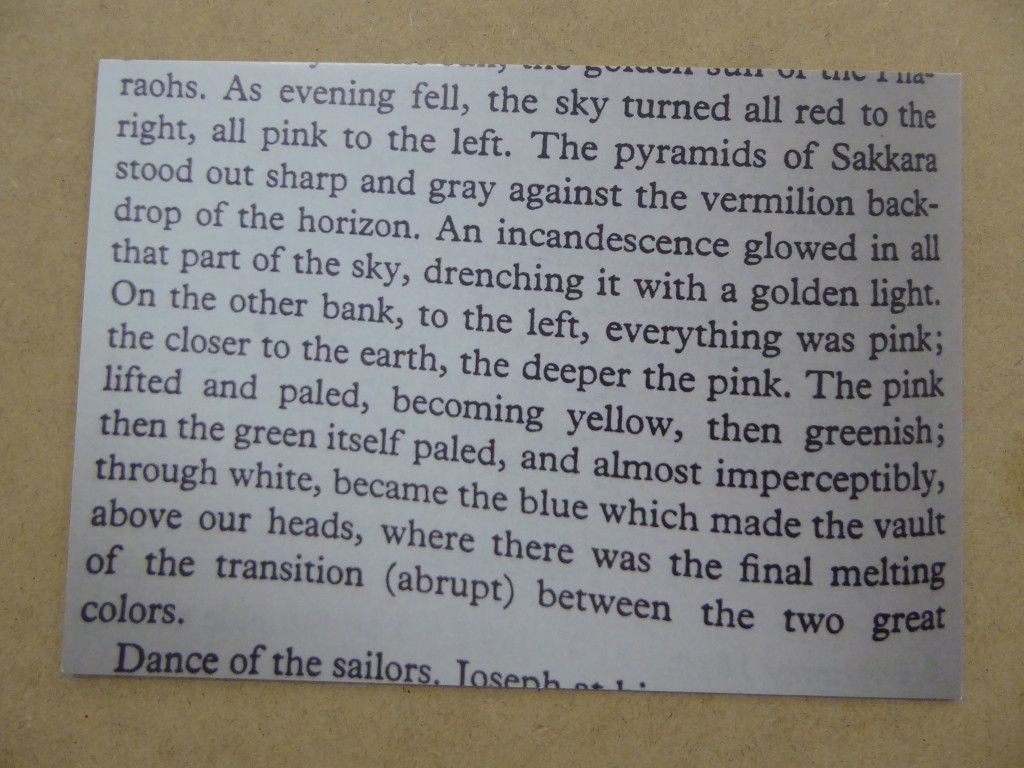
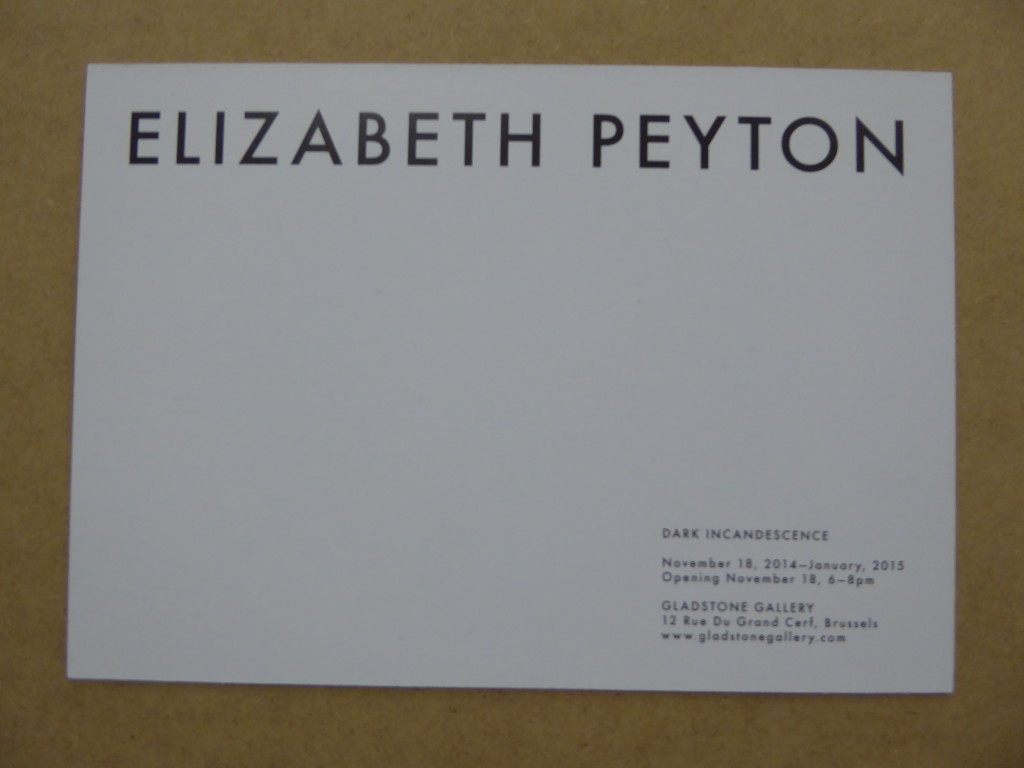
Dark Incandescence exhibition @ Gladstone Gallery, Brussels
specific object/david platzker
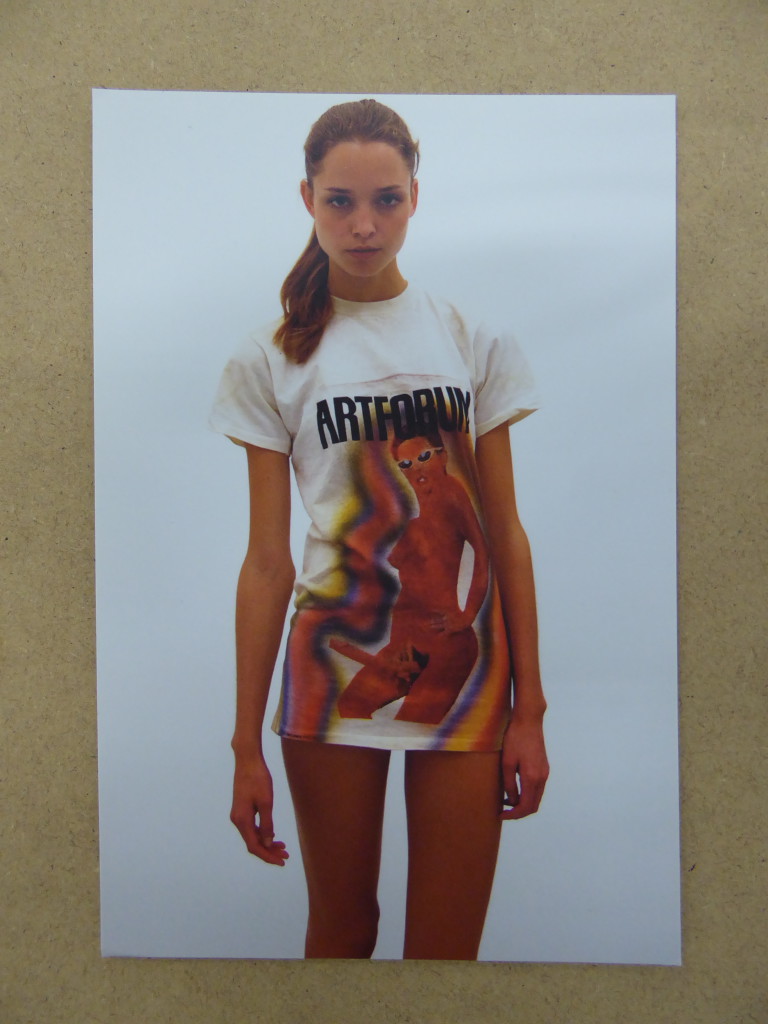
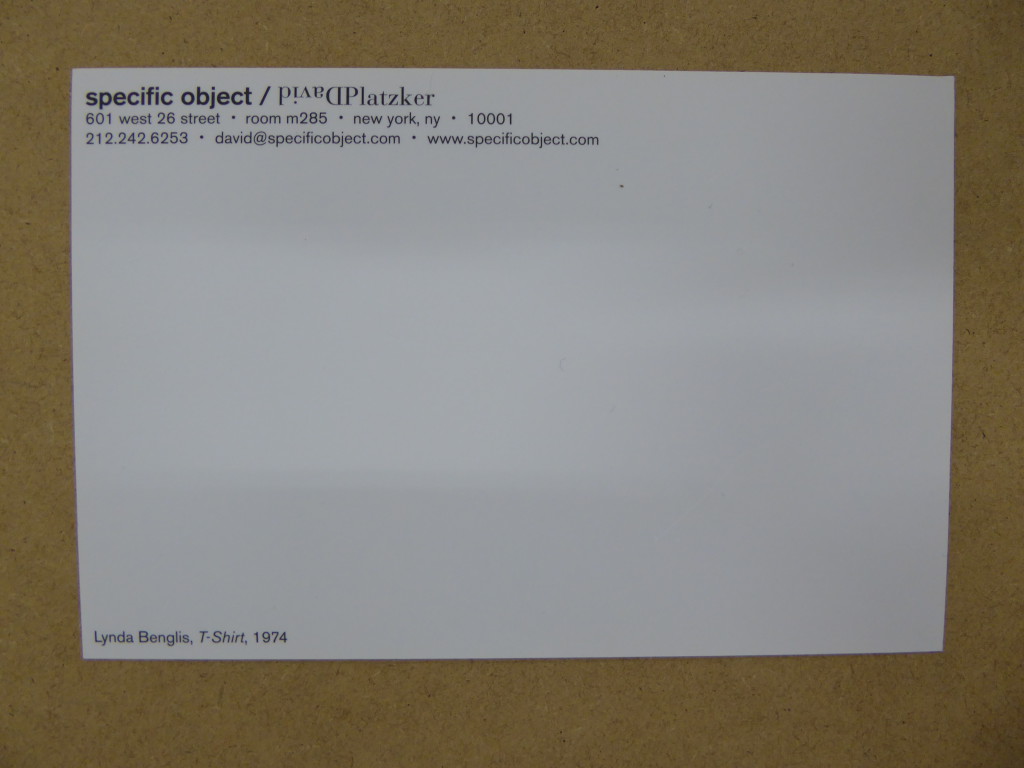
Die Bildkomposition sprach mich sofort an.
In der Setzung mit den anderen Karten zeigt diese eine einzelne Person.
Die Karte ist ästhetisch und gehaltvoll.
Snow Job
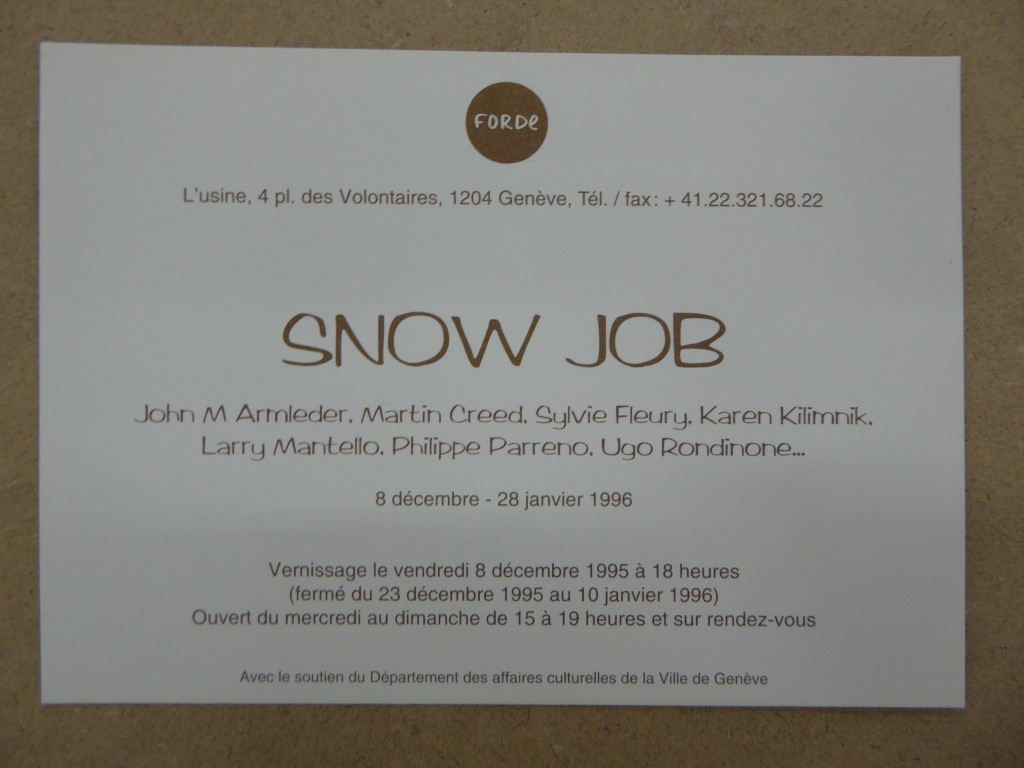
Guter Titel
Anna von Bühl
One for the money…Two for the Show..! Klat
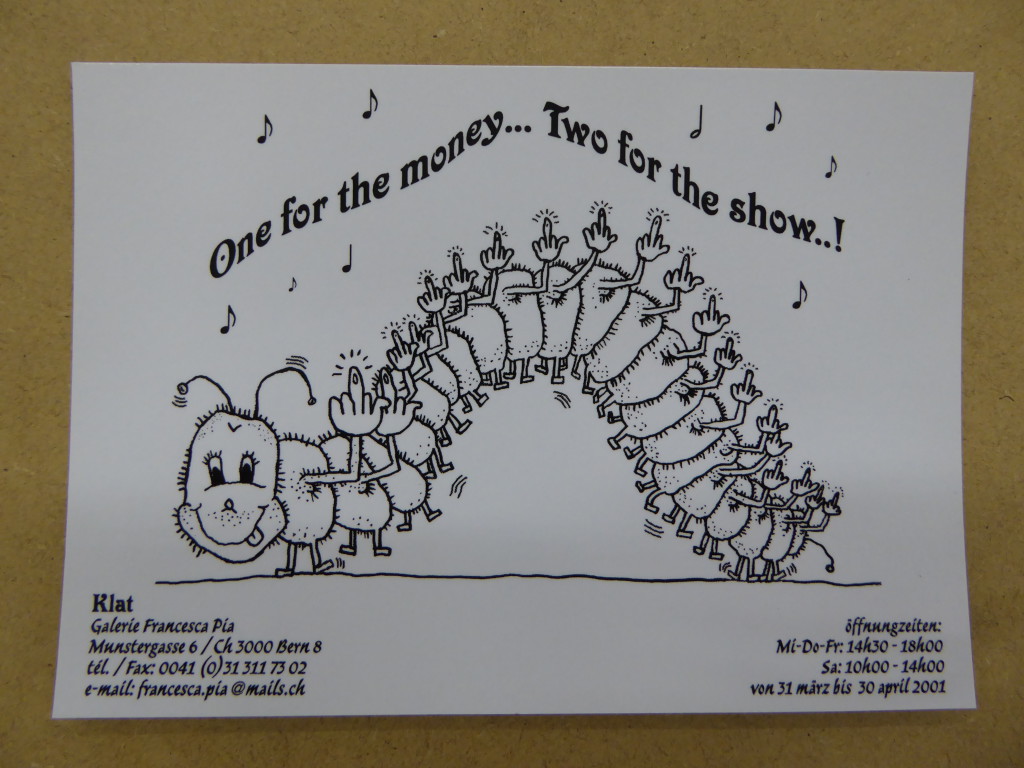
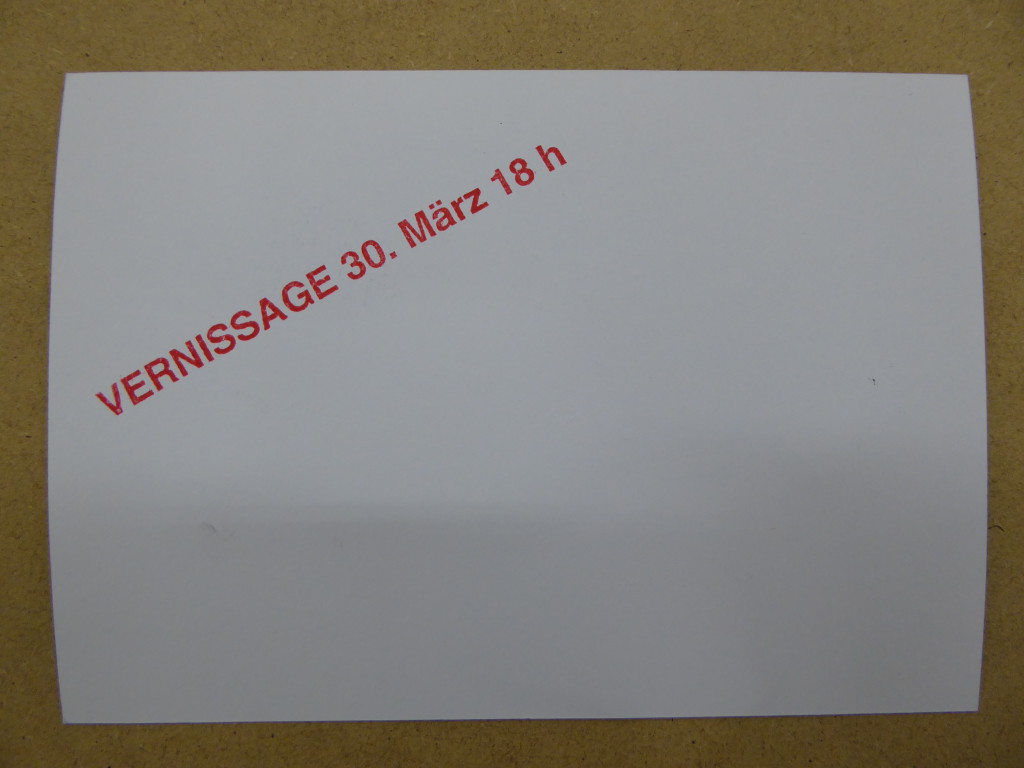
Wir mögen Tiere
Fischli and Weiss – Büsi (Kitty) 2001
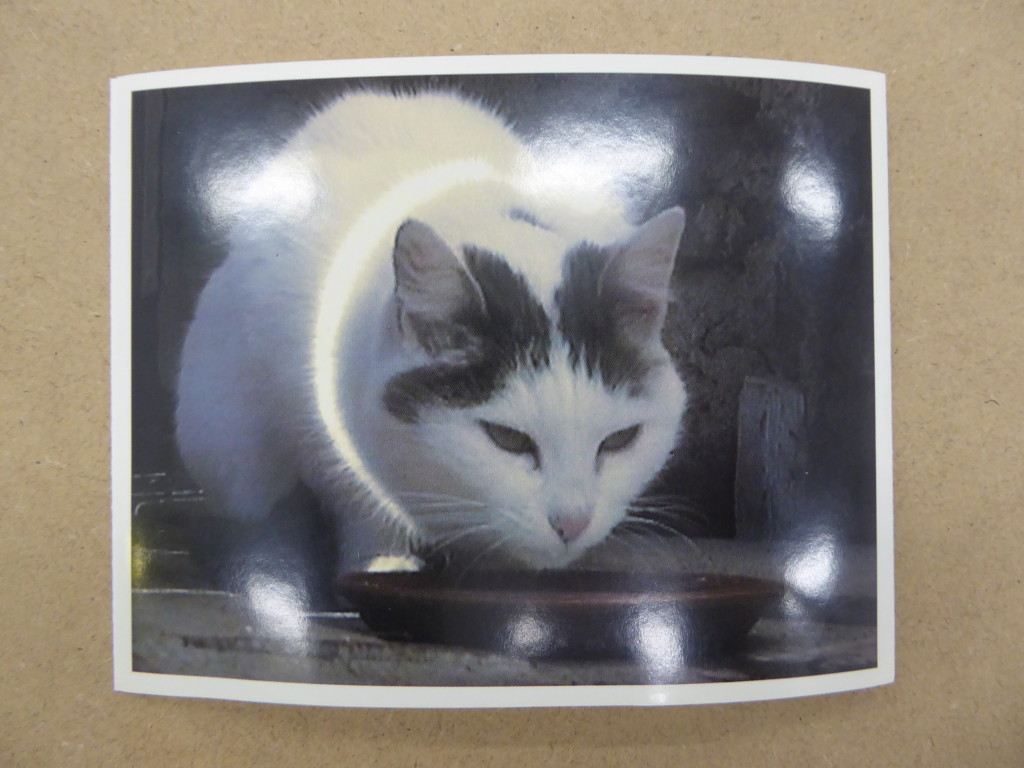
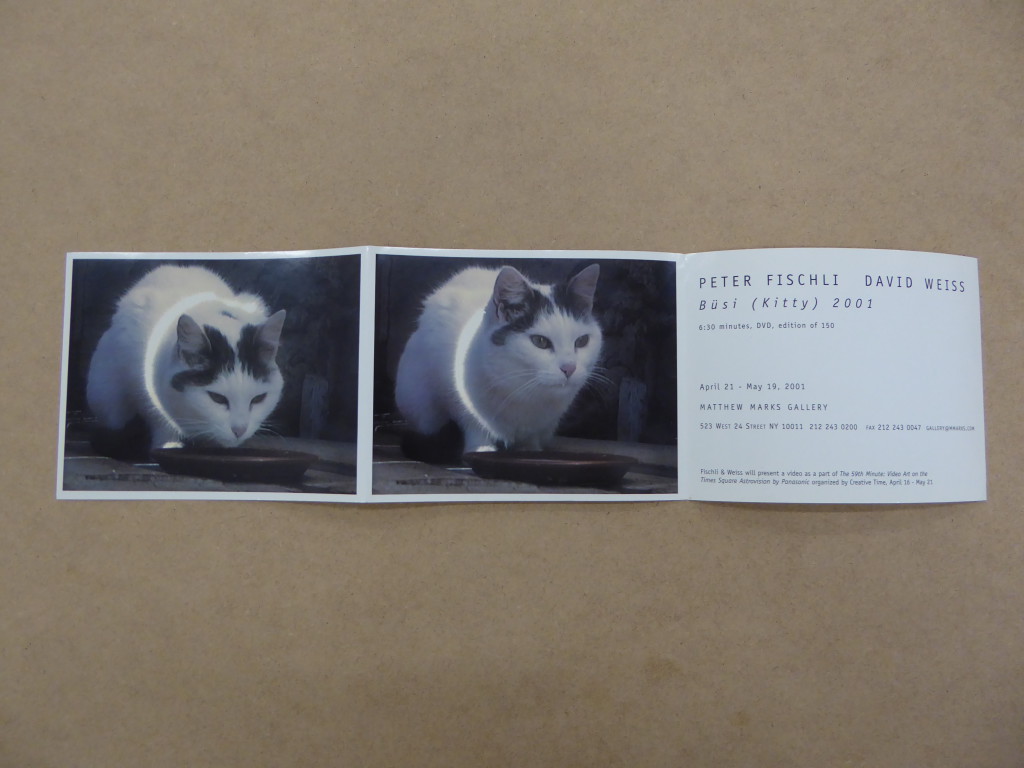
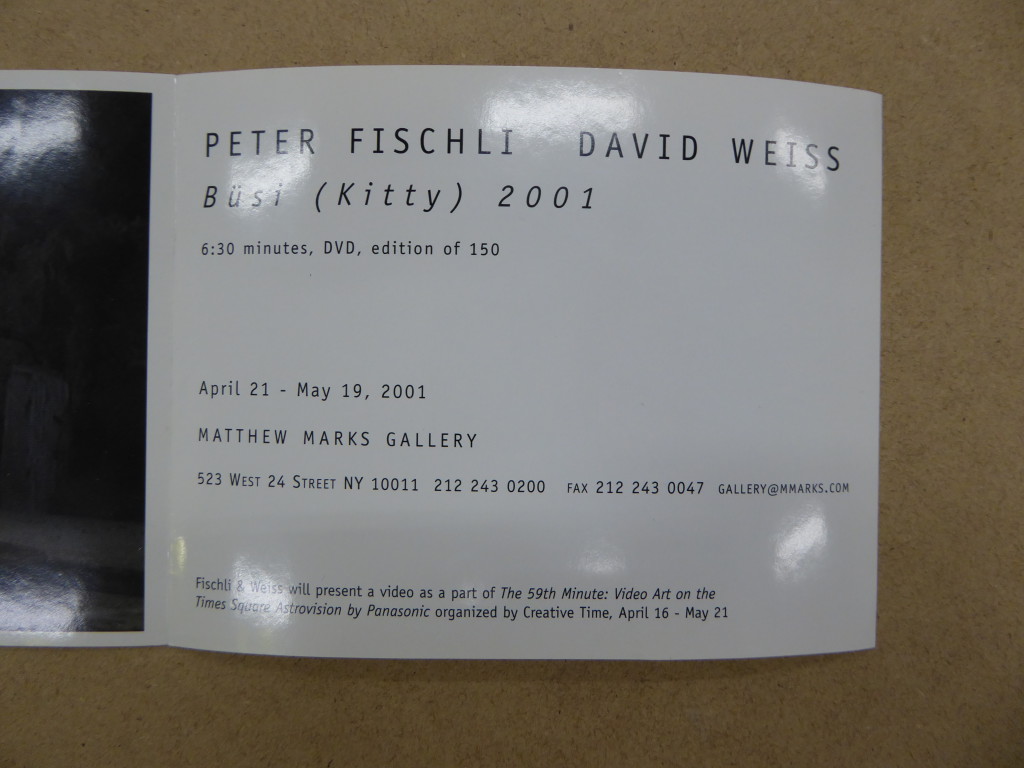
Weil wir Tiere lieben.
Sophie Faurer
Yes Bruce Nauman
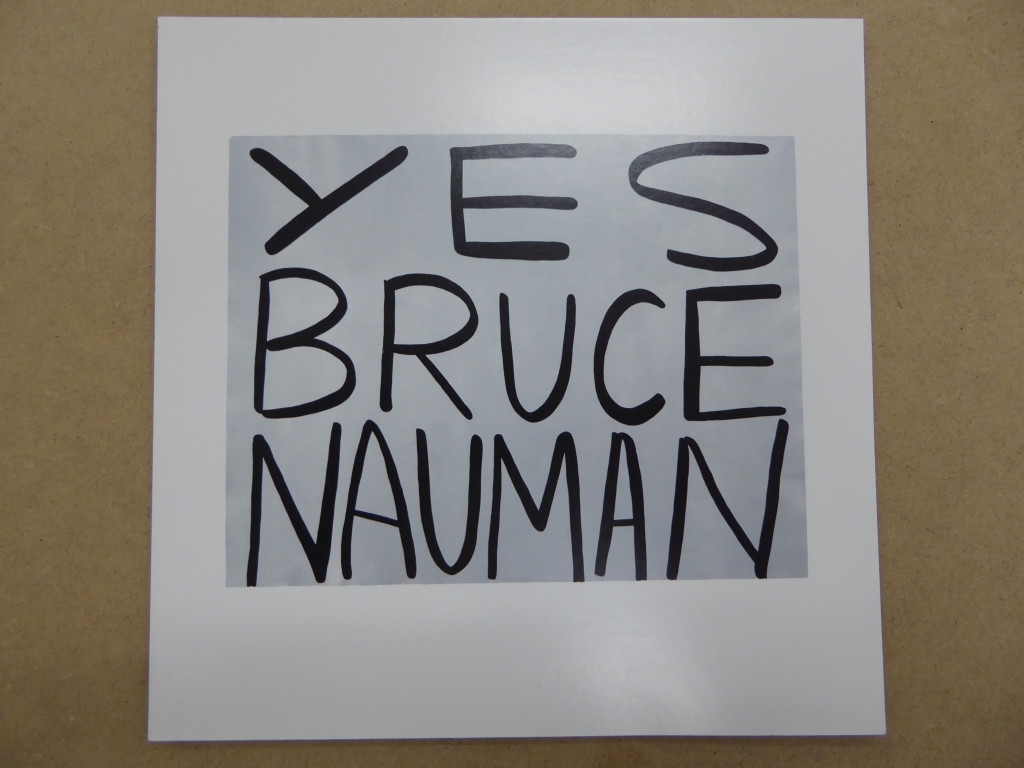
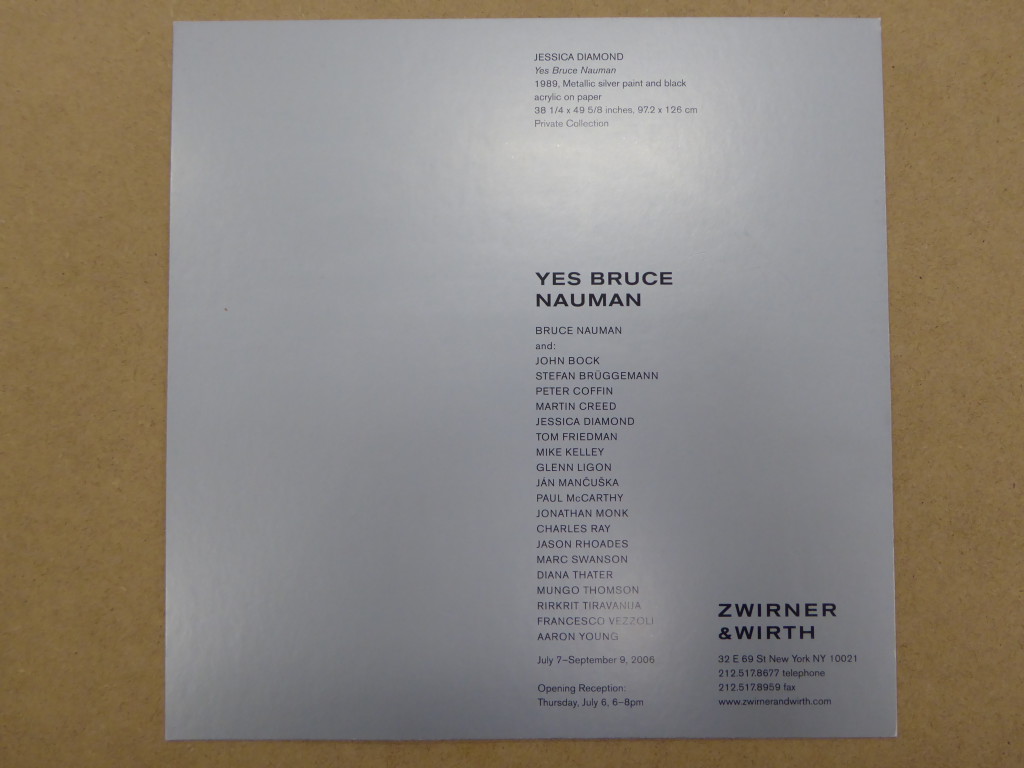
Because Yes!
Joanna de la Fontaine
The Modern Institute/Toby Webster Ltd
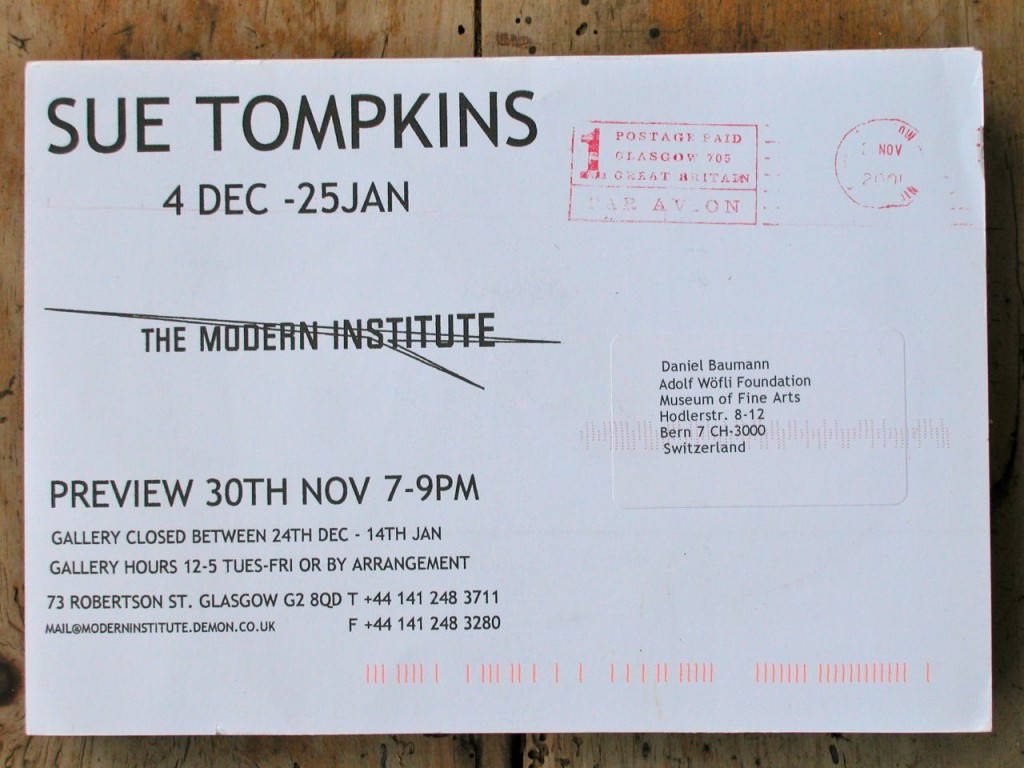
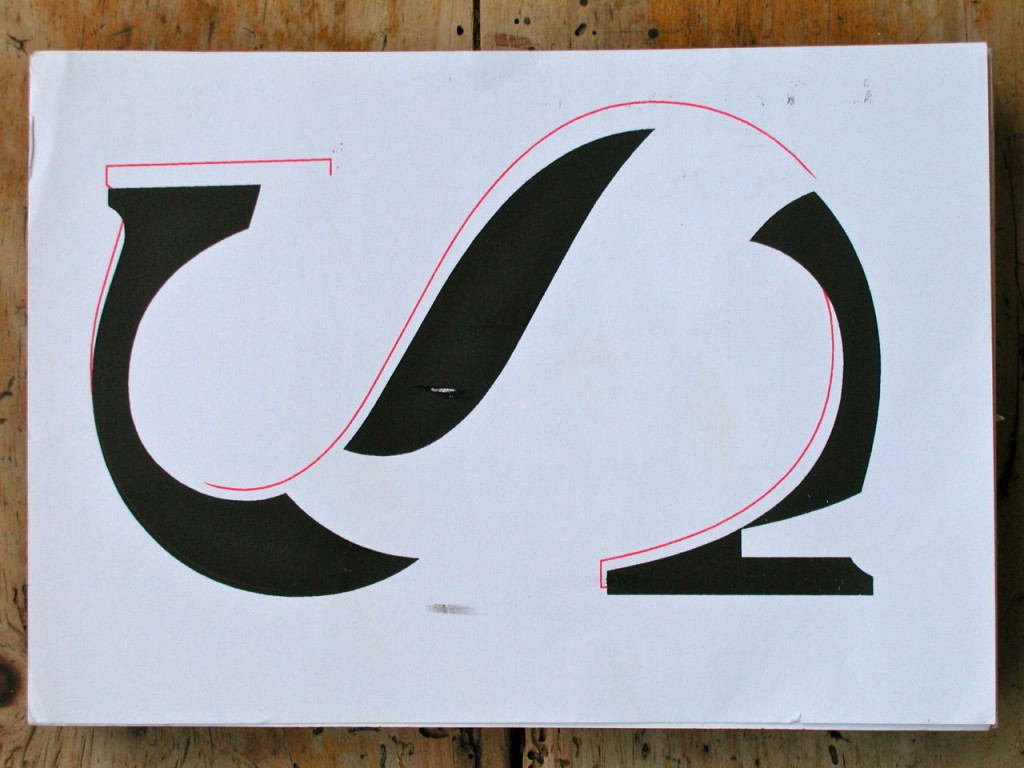
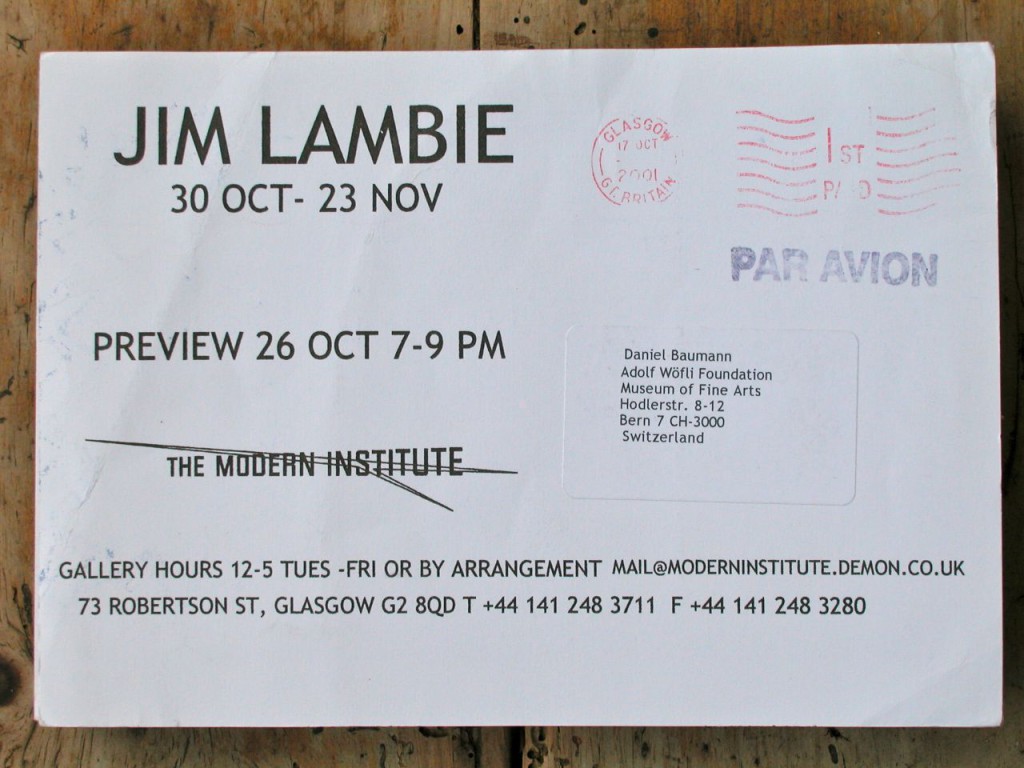
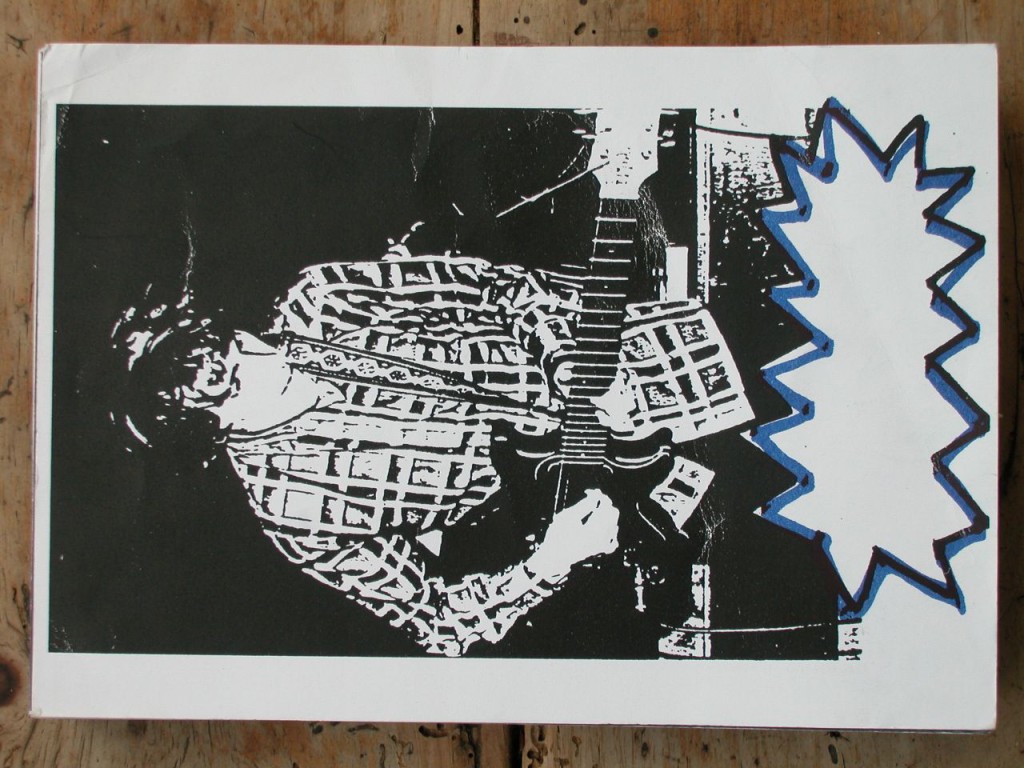
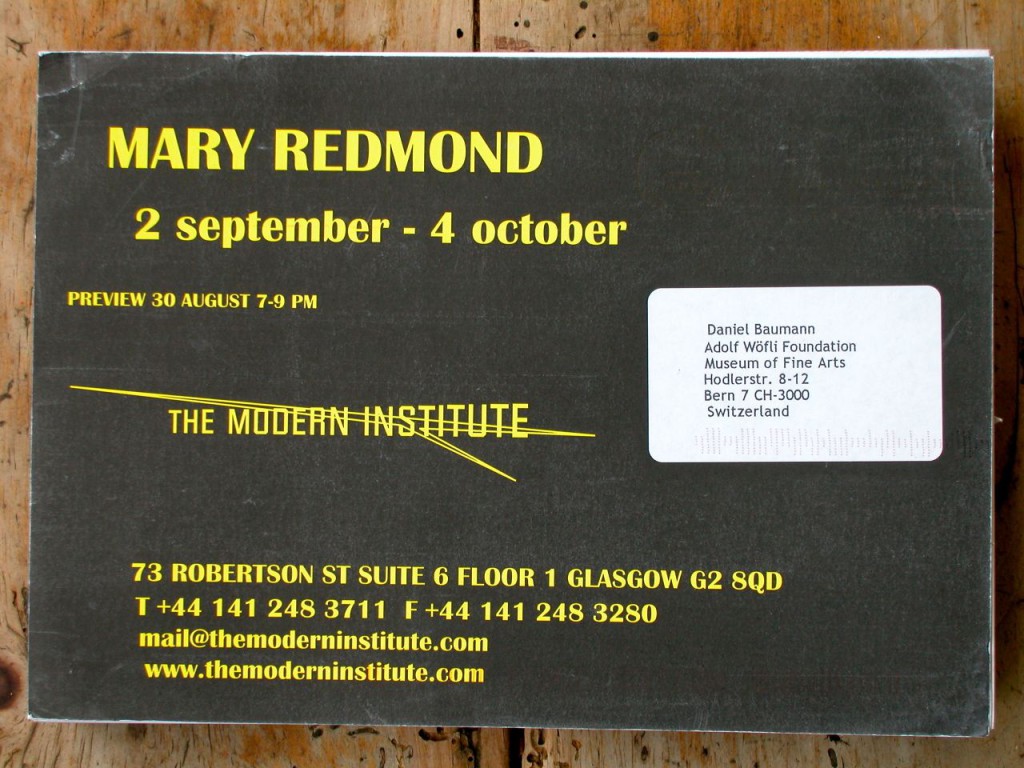
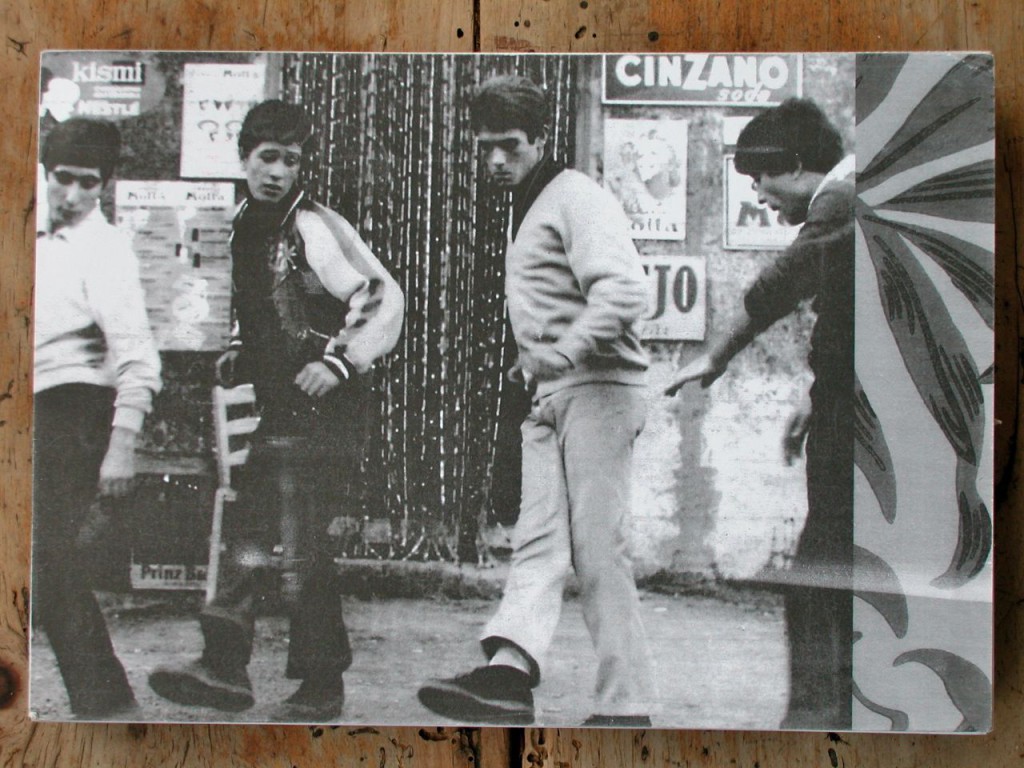
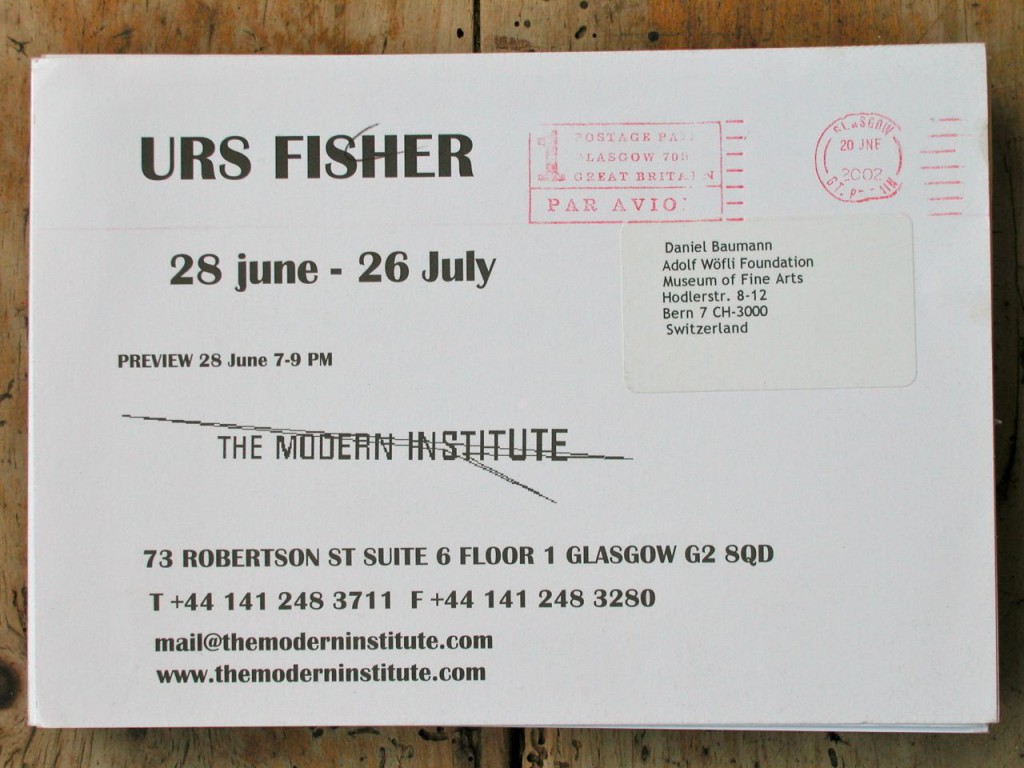
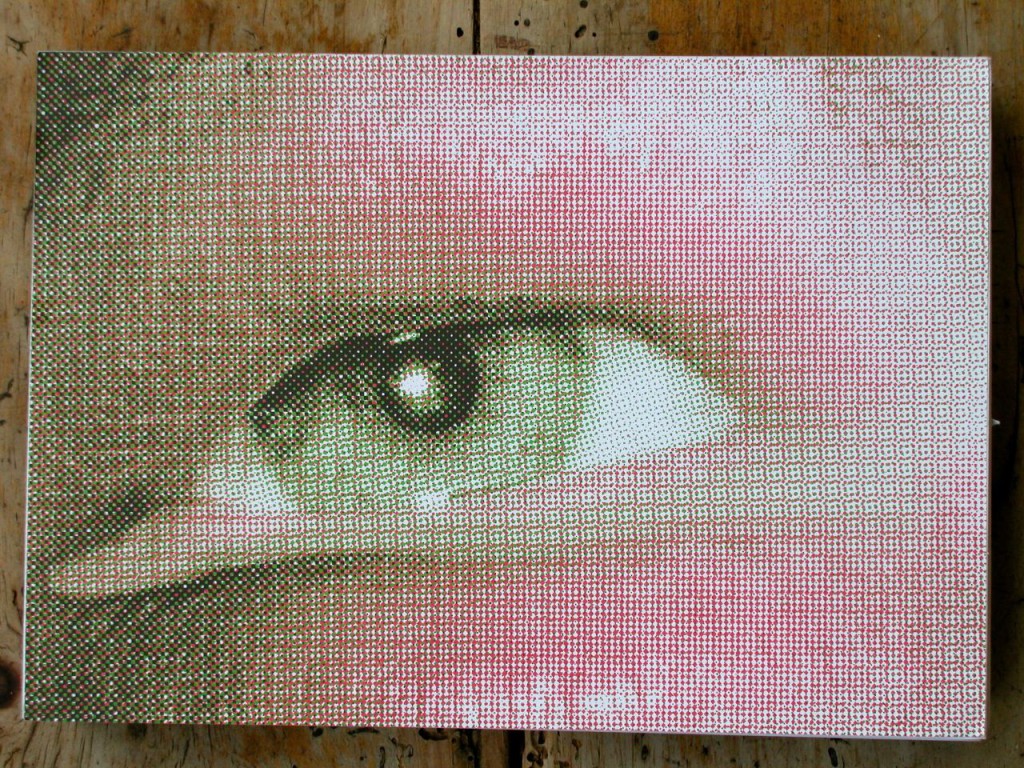
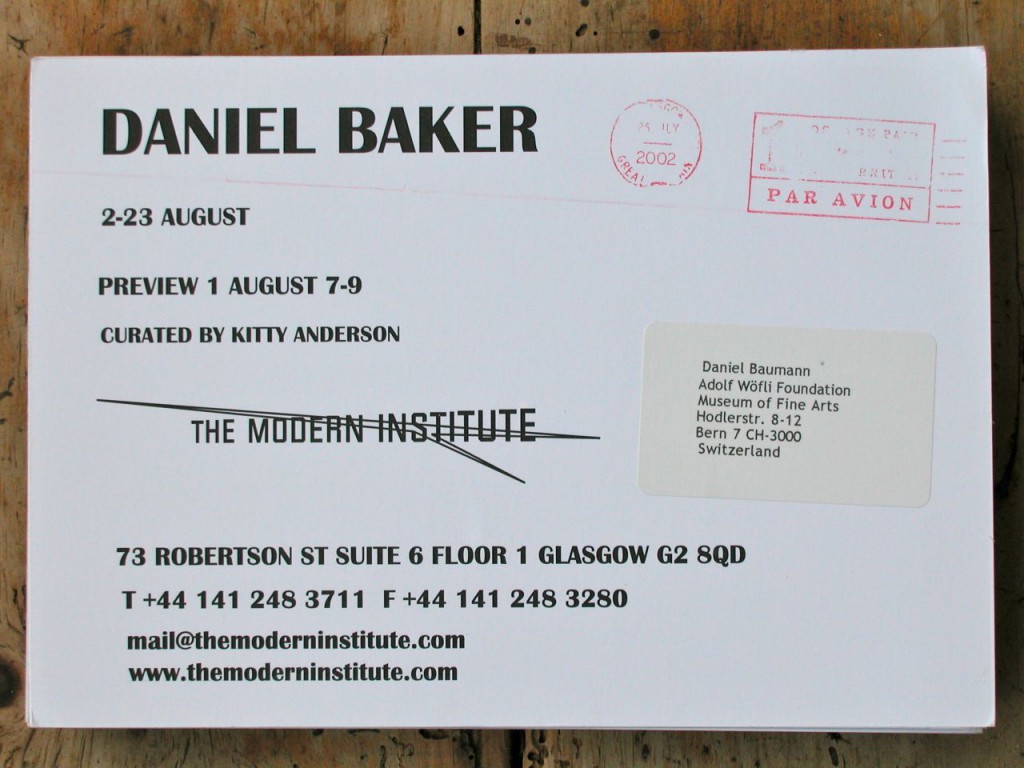
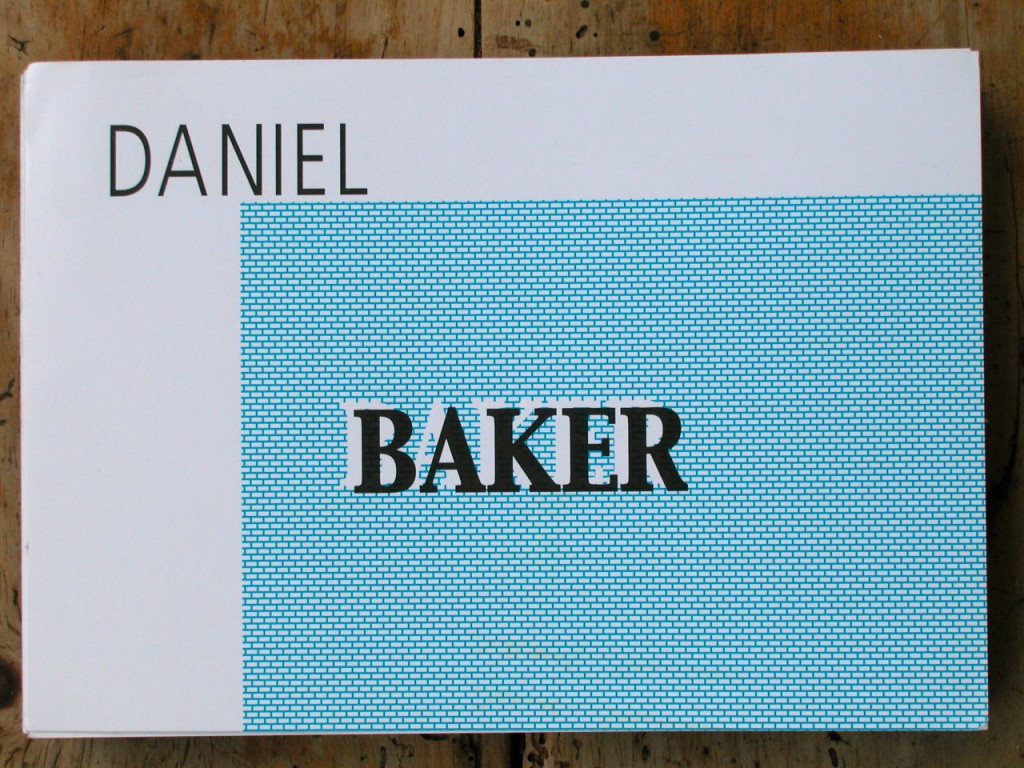
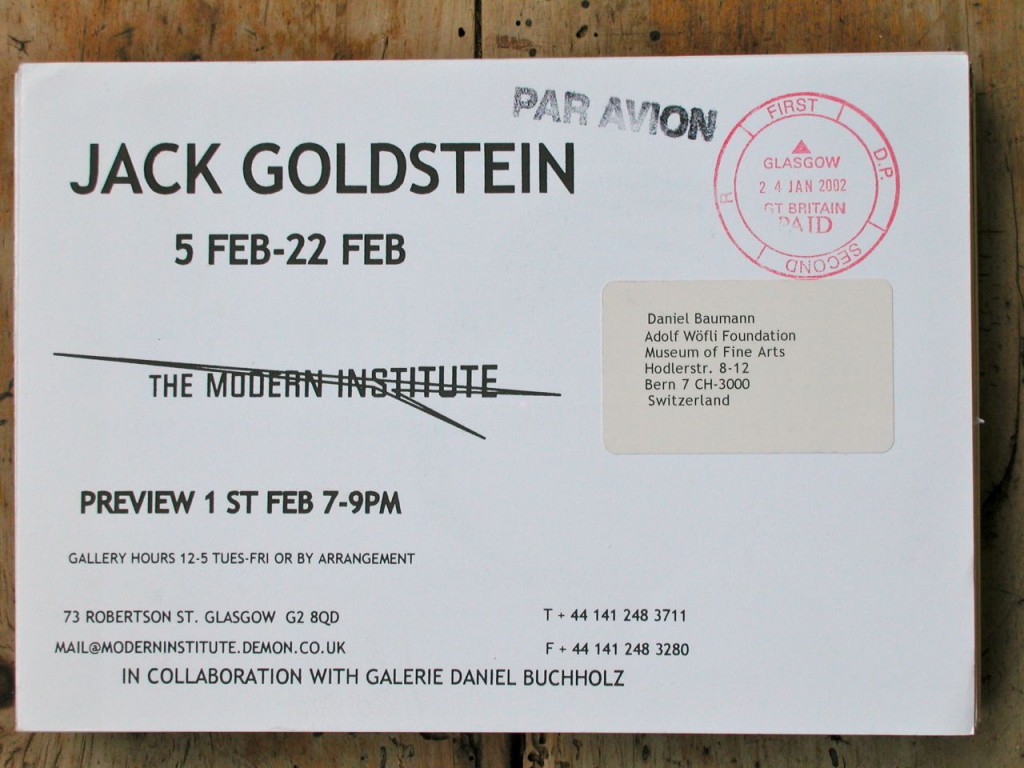

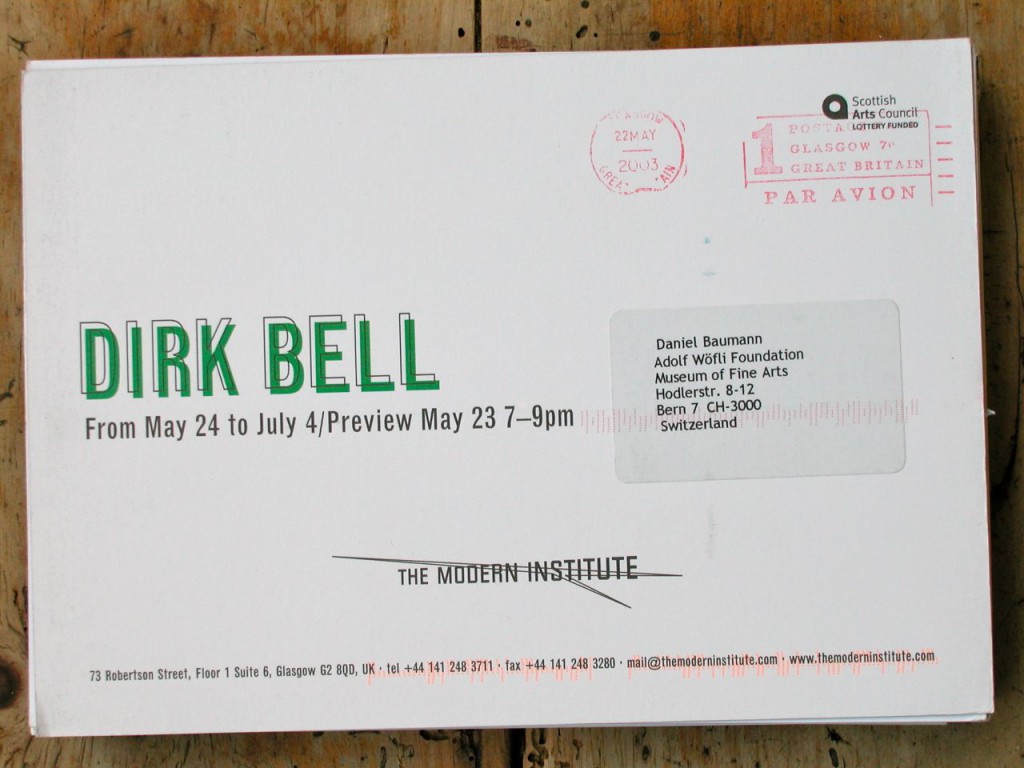
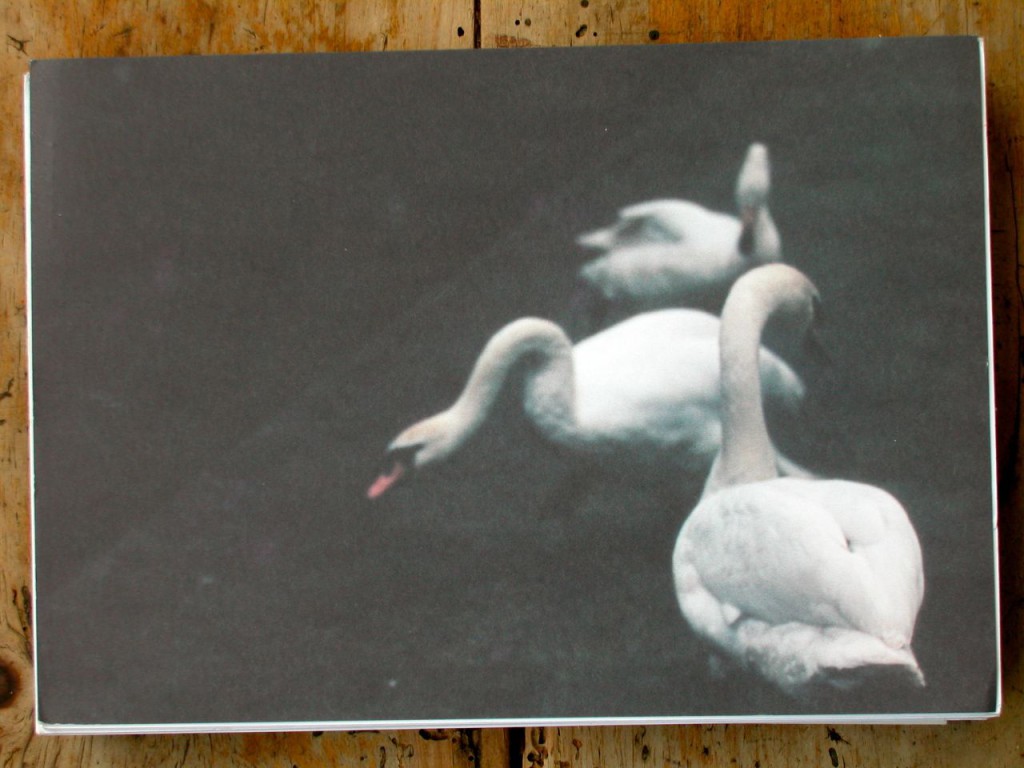
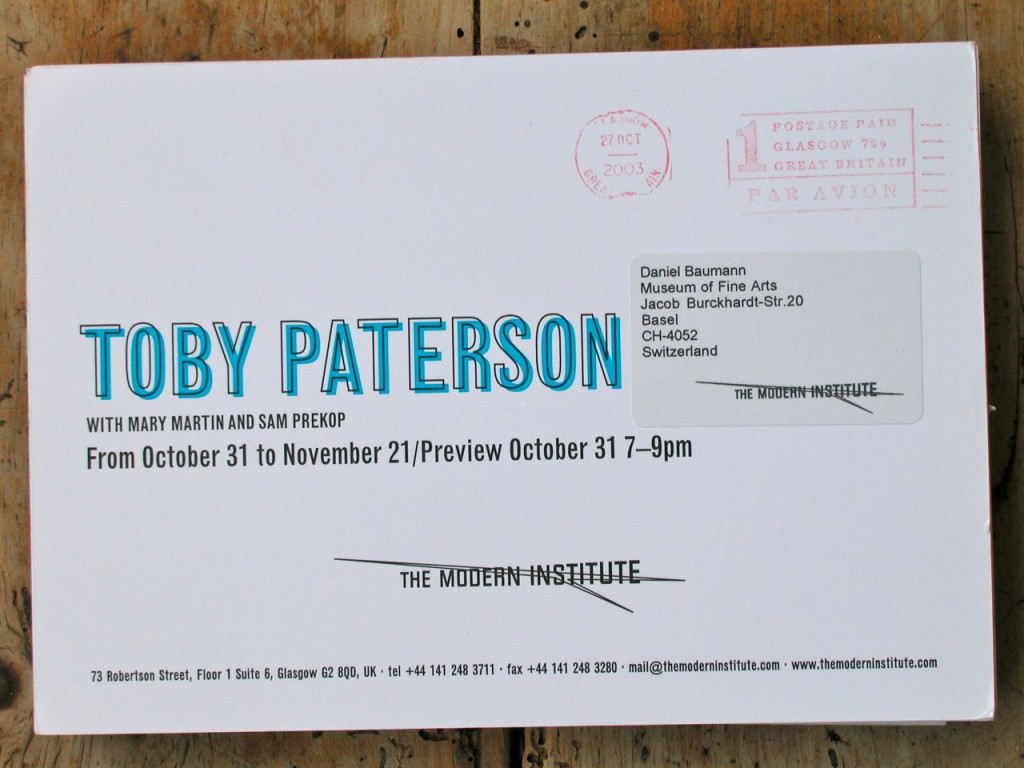
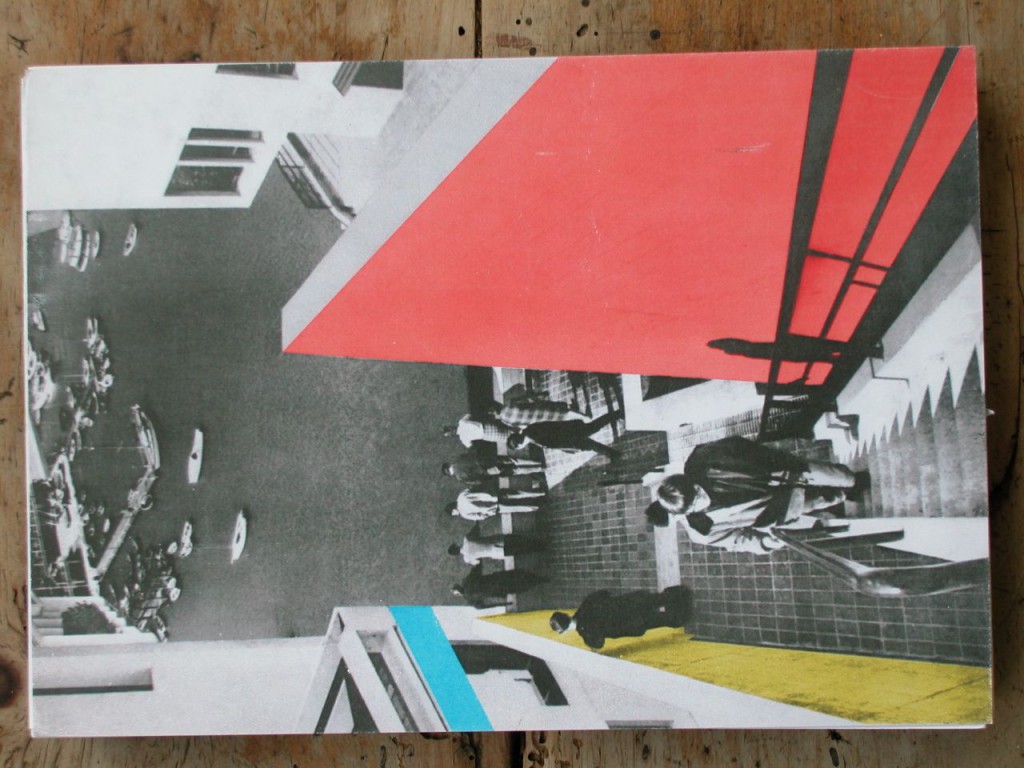
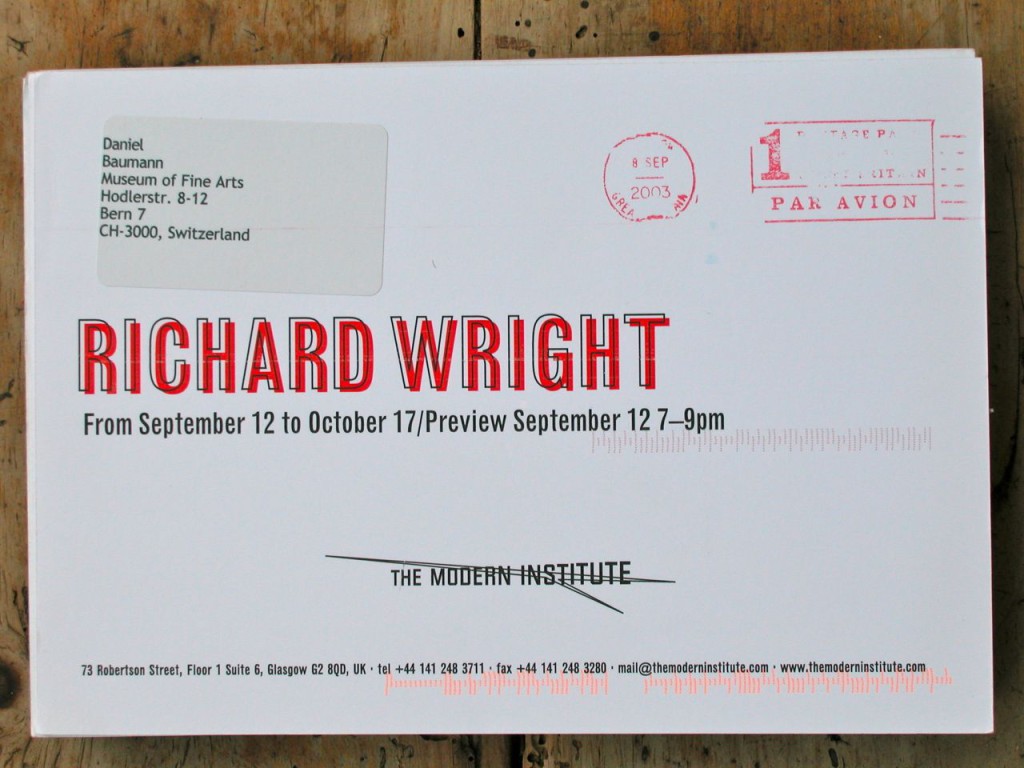
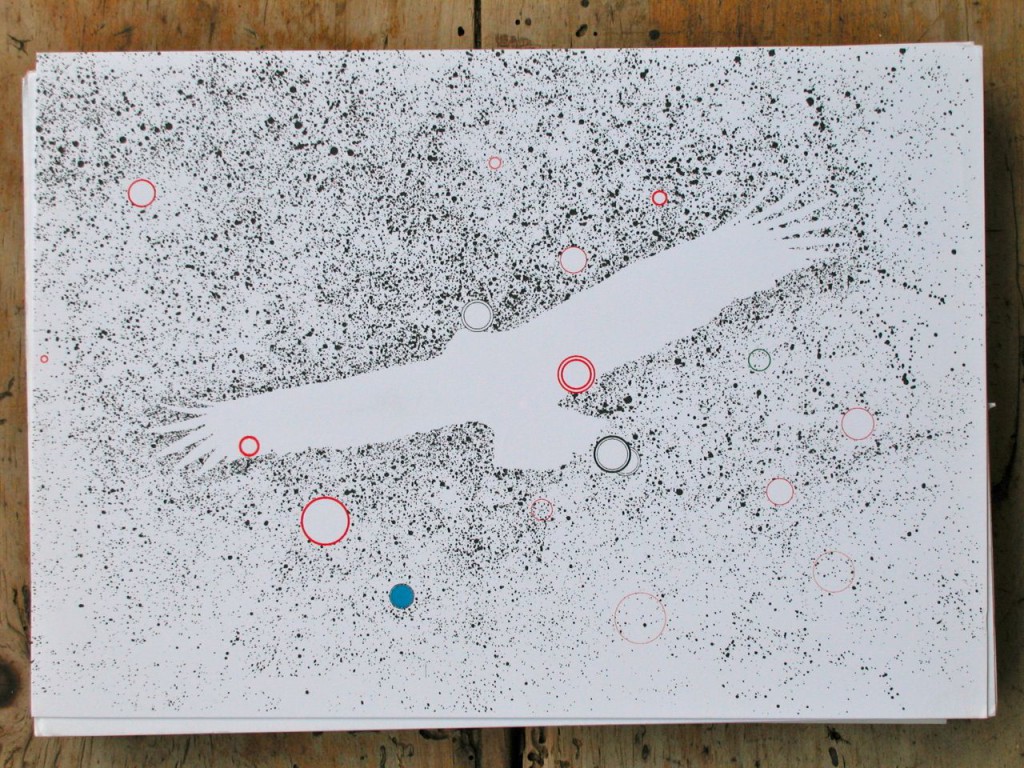
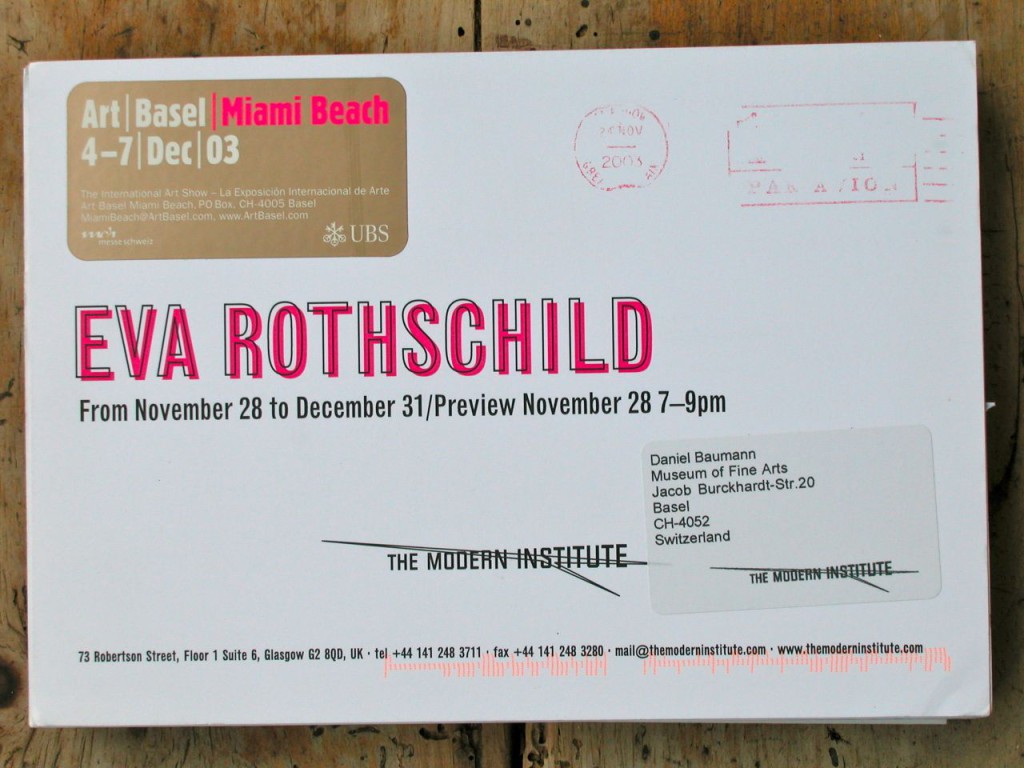
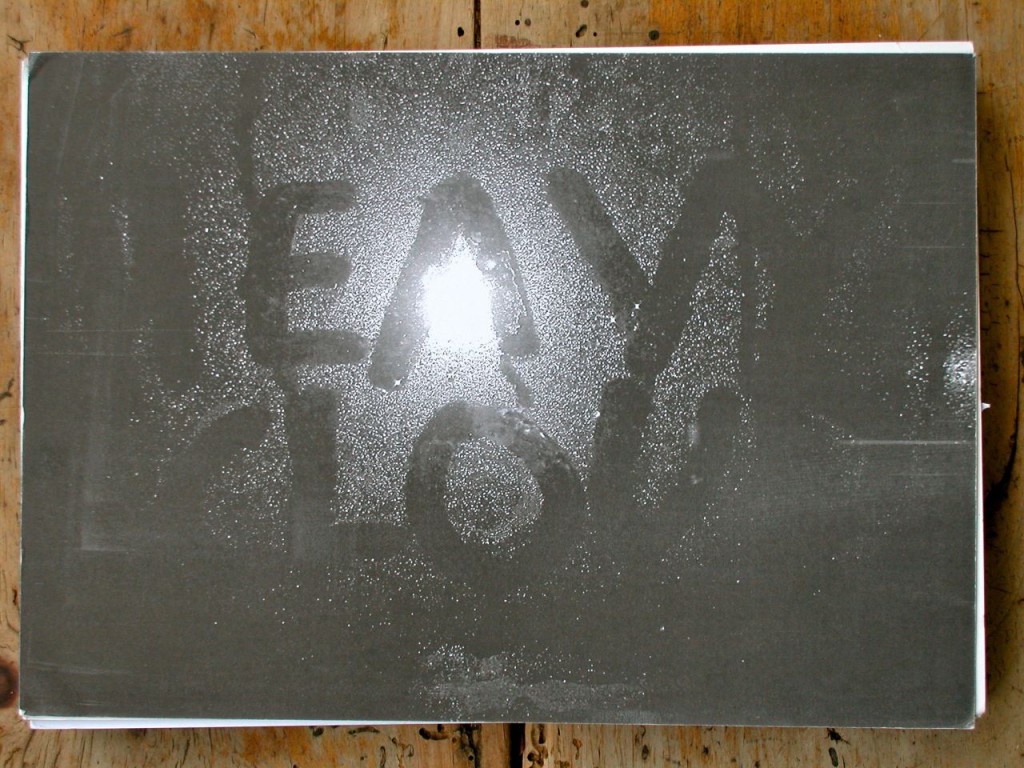
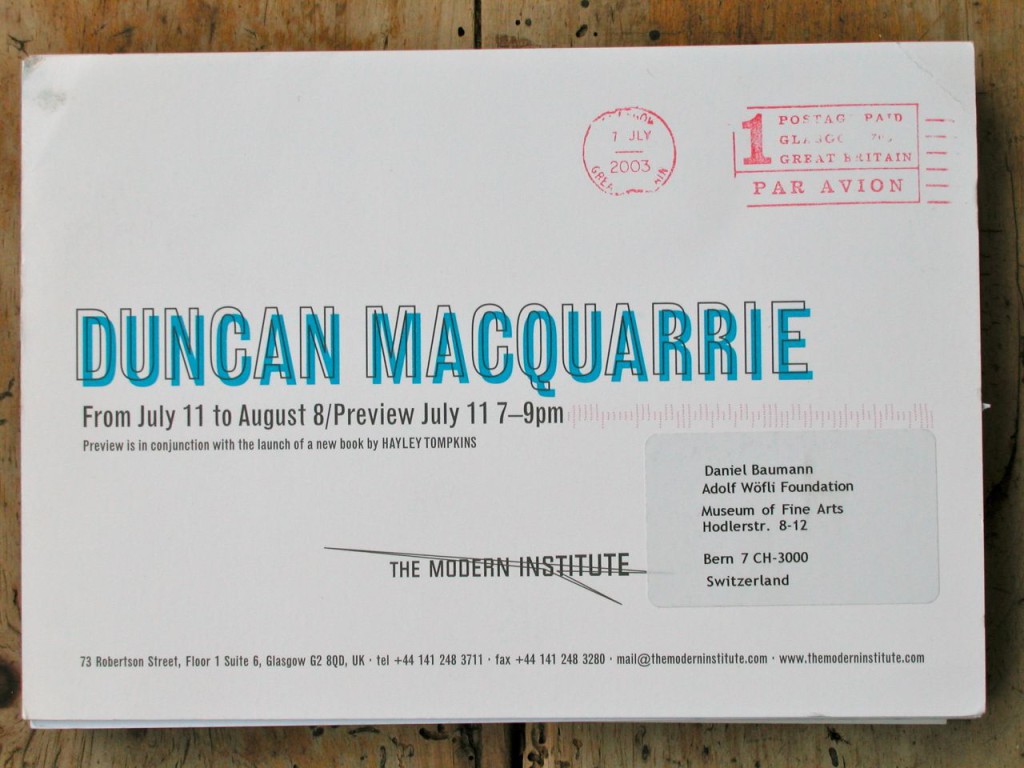
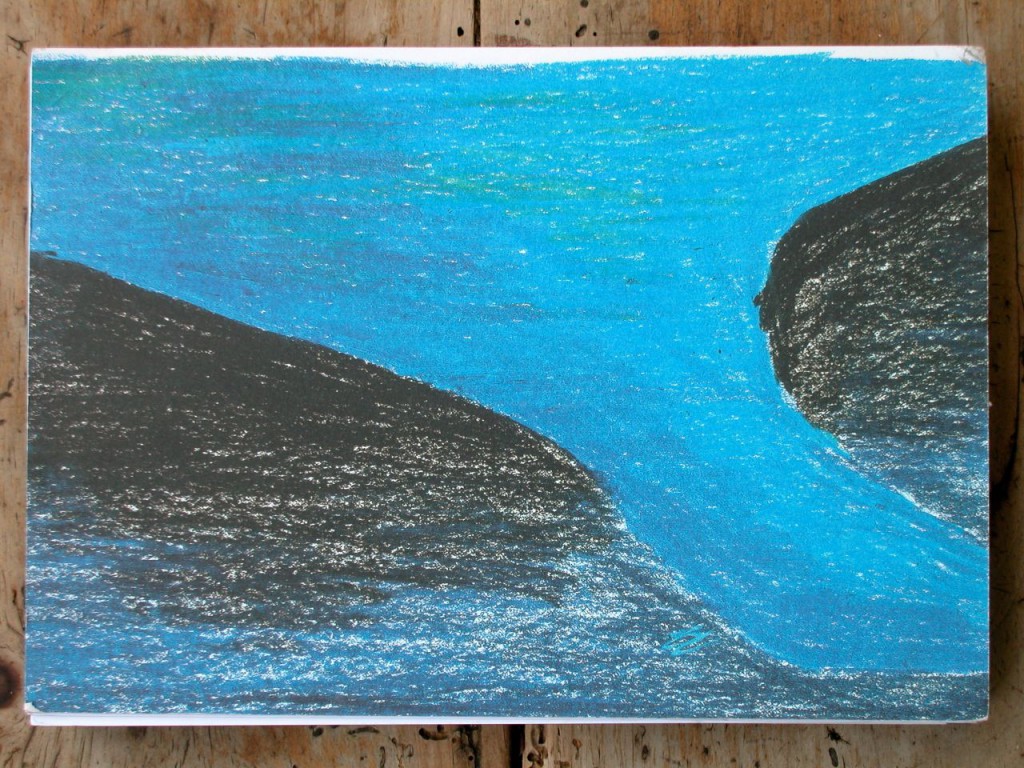

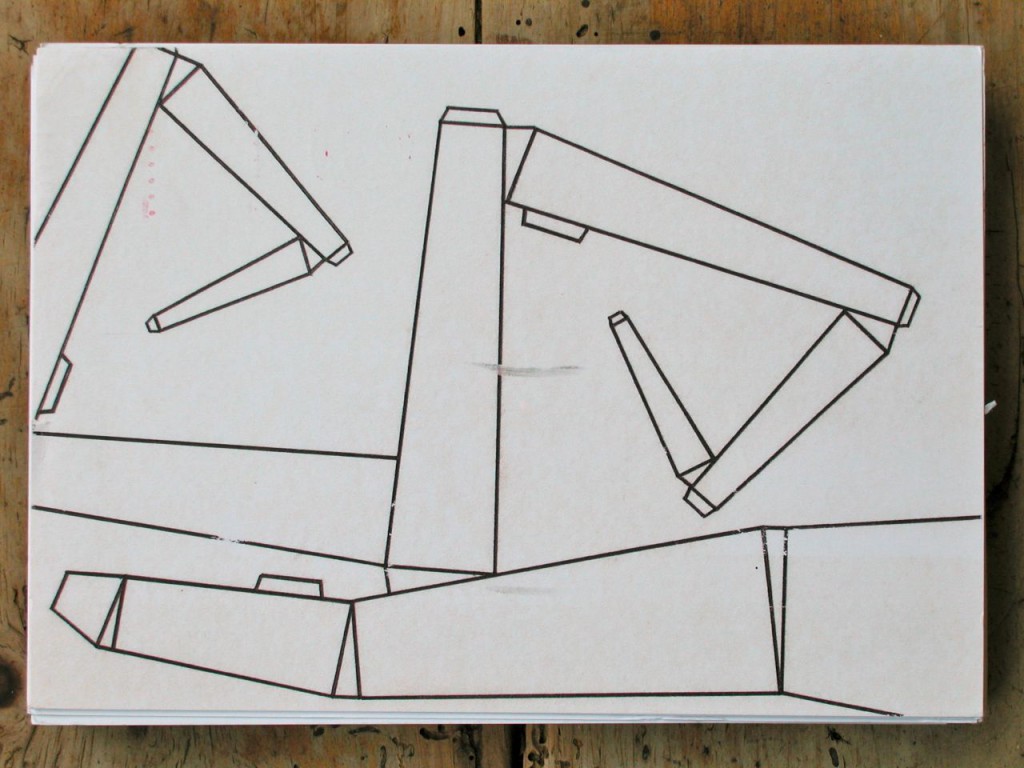
The Modern Institute/Toby Webster Ltd was founded by former Tramway director Charles Esche, writer and curator Will Bradley and Toby Webster in 1997 (Esche left in 1999, Bradley in 2001). In 2006, Andrew Hamilton became Webster’s partner. As Time Out puts it: “A perfect example of Glasgow’s internationally renowned contribution to contemporary art, The Modern Institute was once described by Art Review magazine as ‘a model for galleries around the world’.” The flyers were originally done on Riso in an old paper store in Glasgow called Nashes, hand fed into the machine. Until today, they keep their special appeal for their low quality, and their choices of colors, forms and fonts. They always reminded me of flyers for some obscure bands and concerts. More on the gallery’s history here. Daniel Baumann
 follow
follow